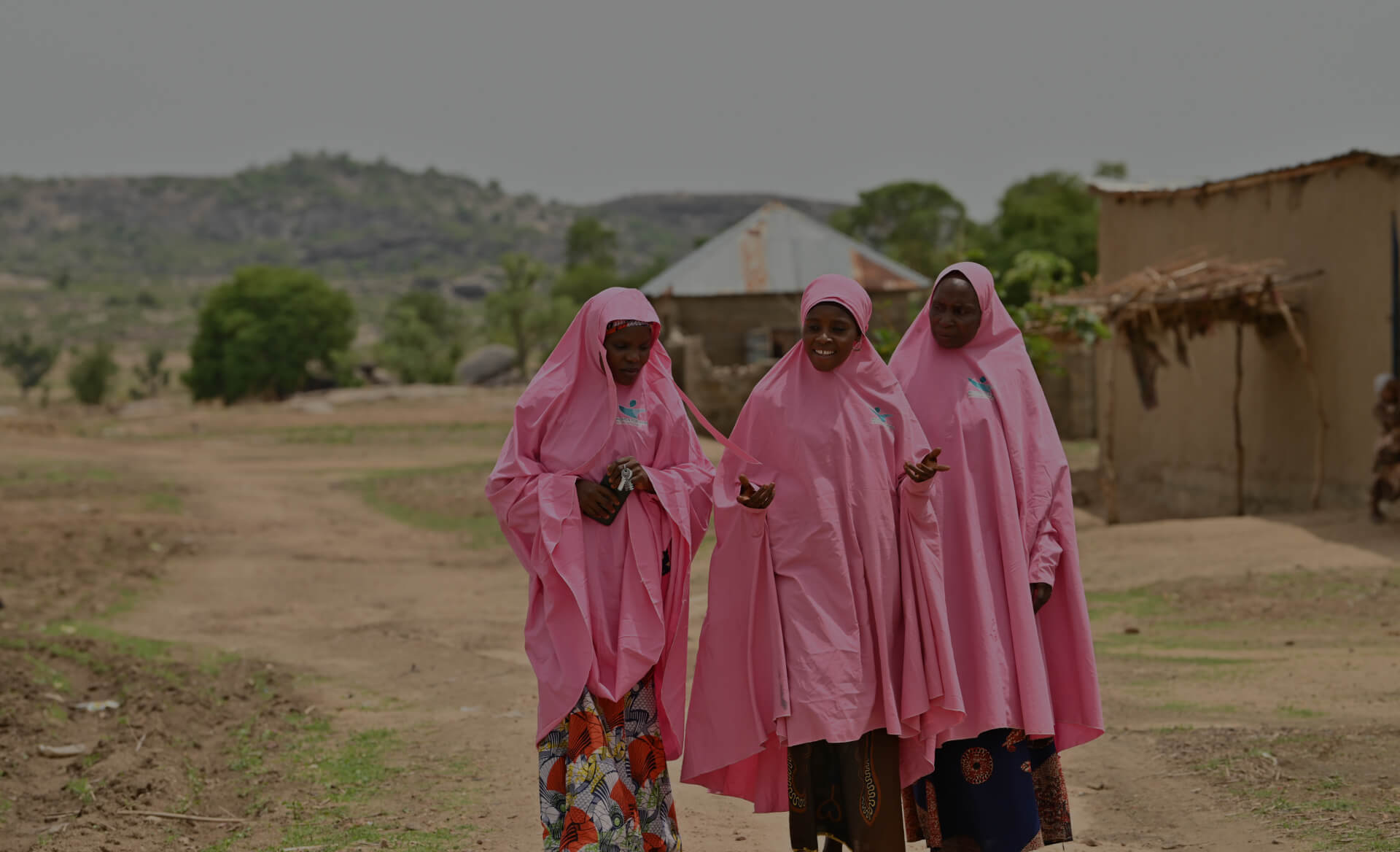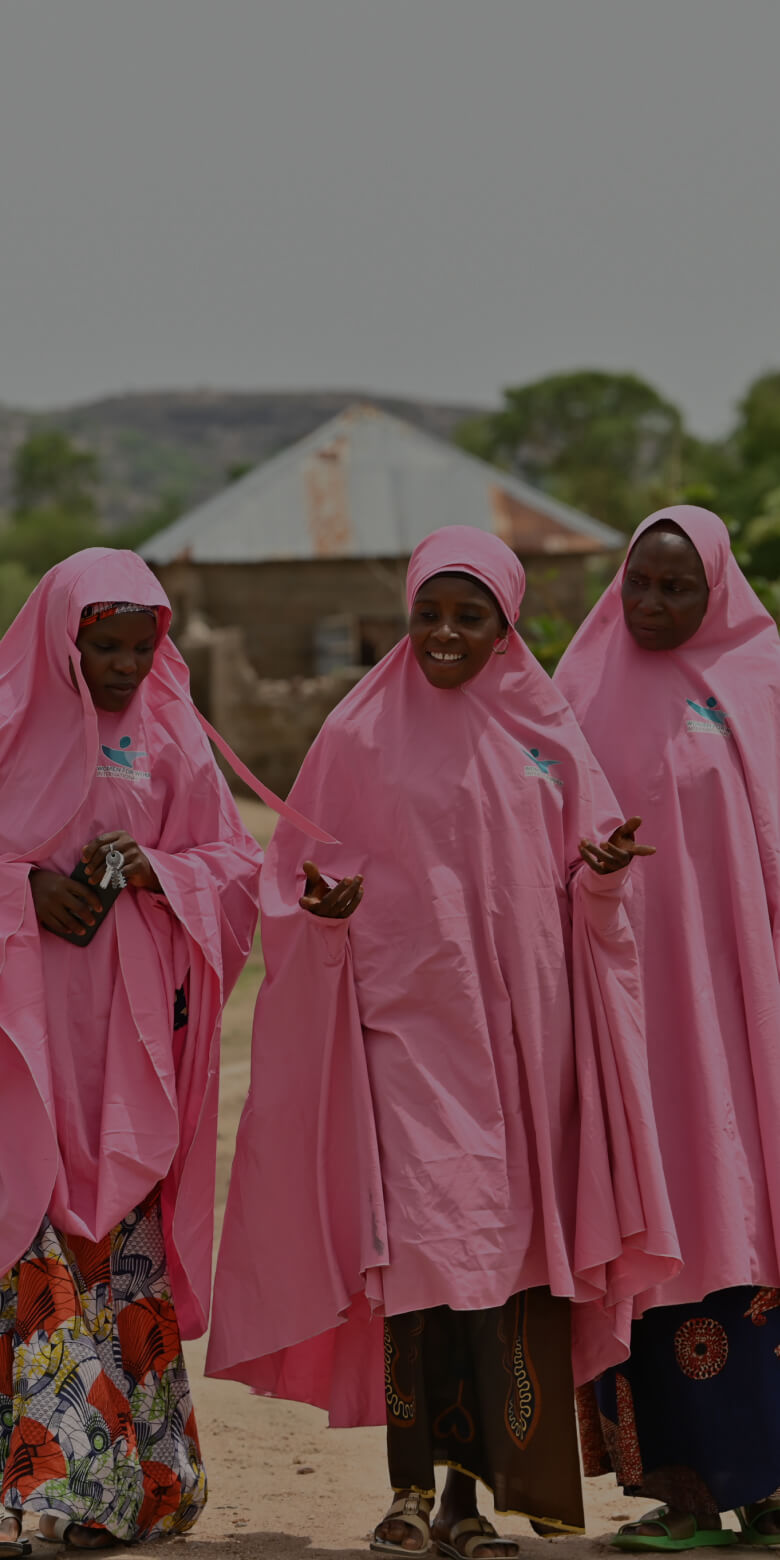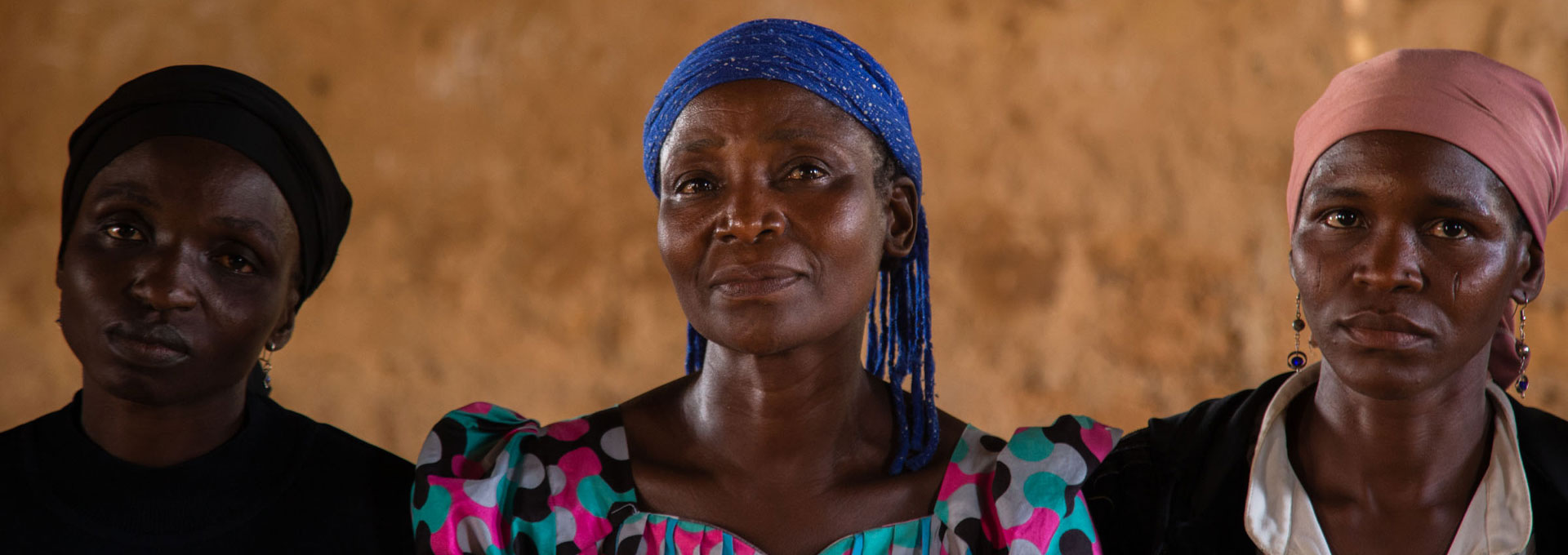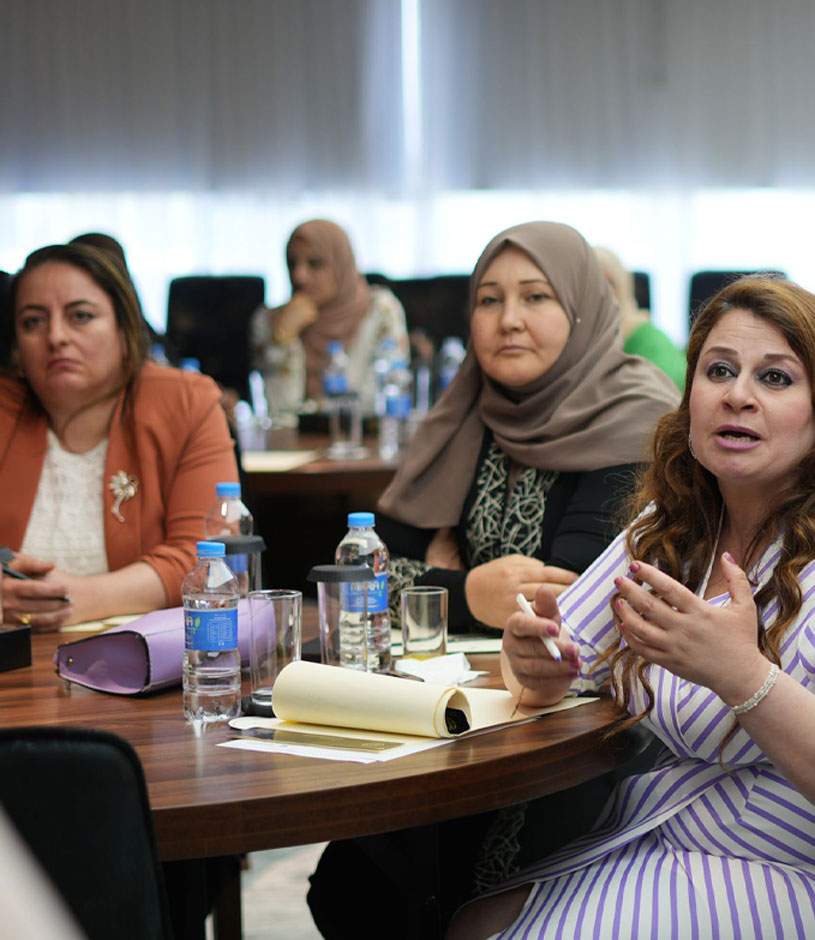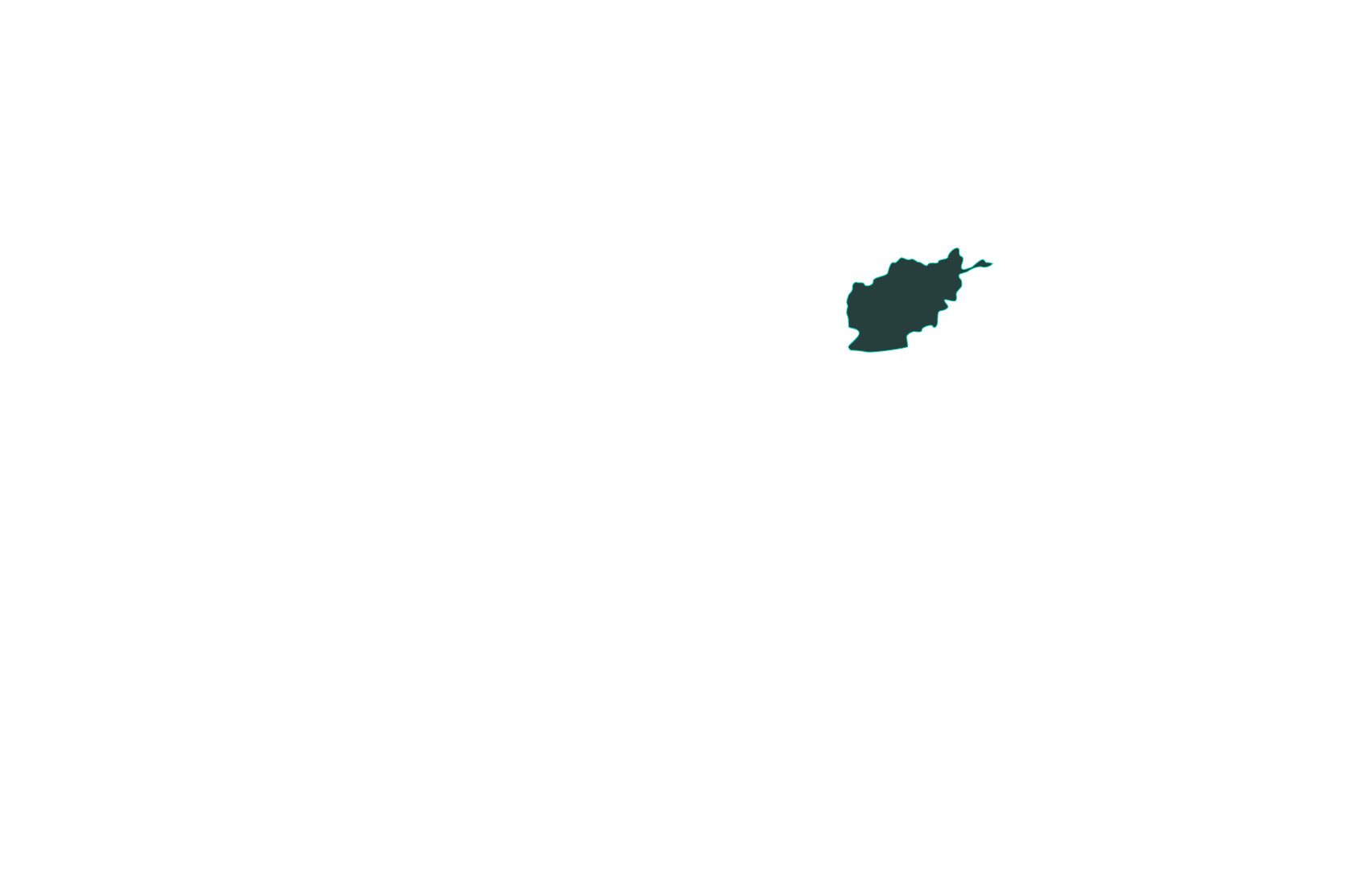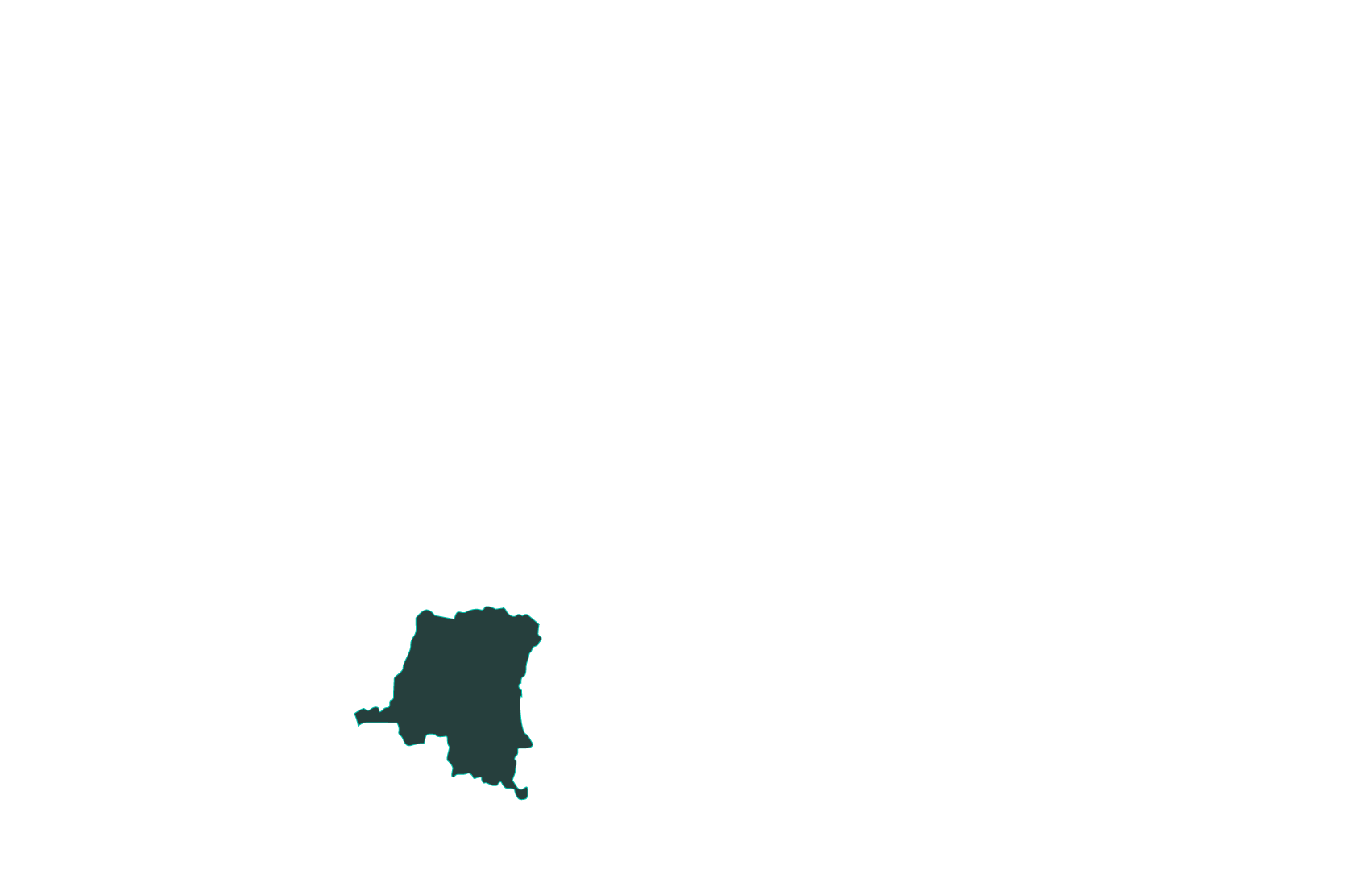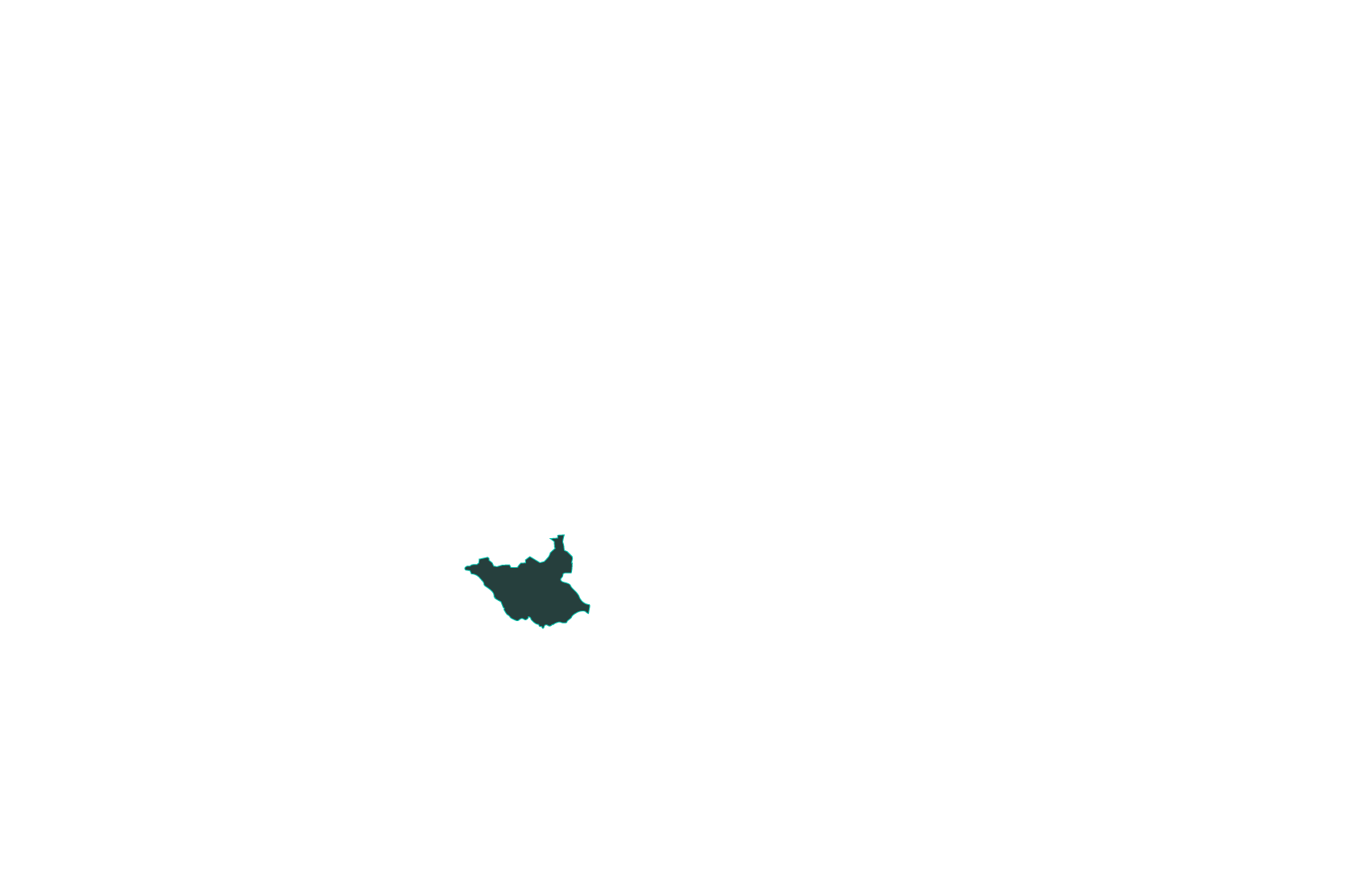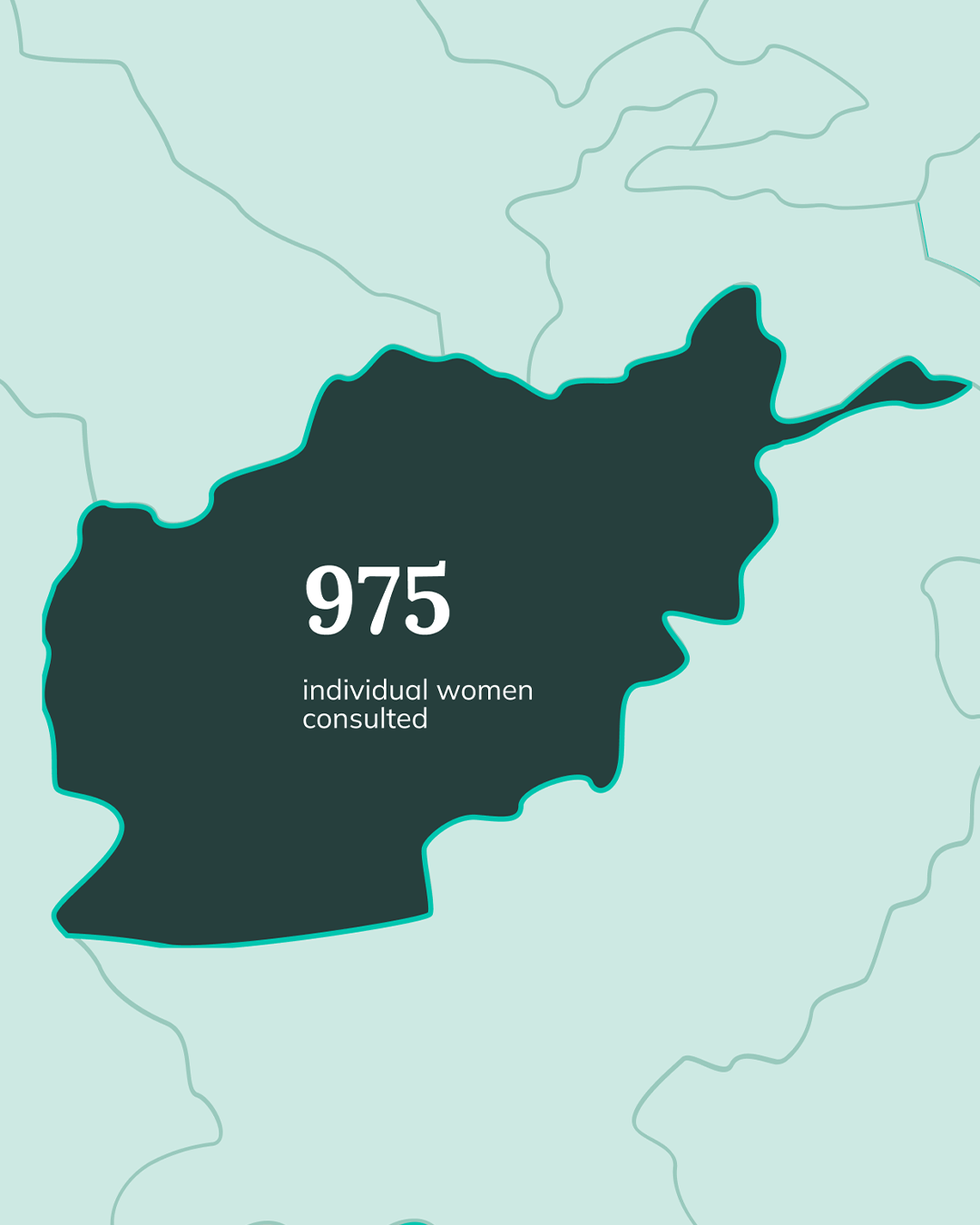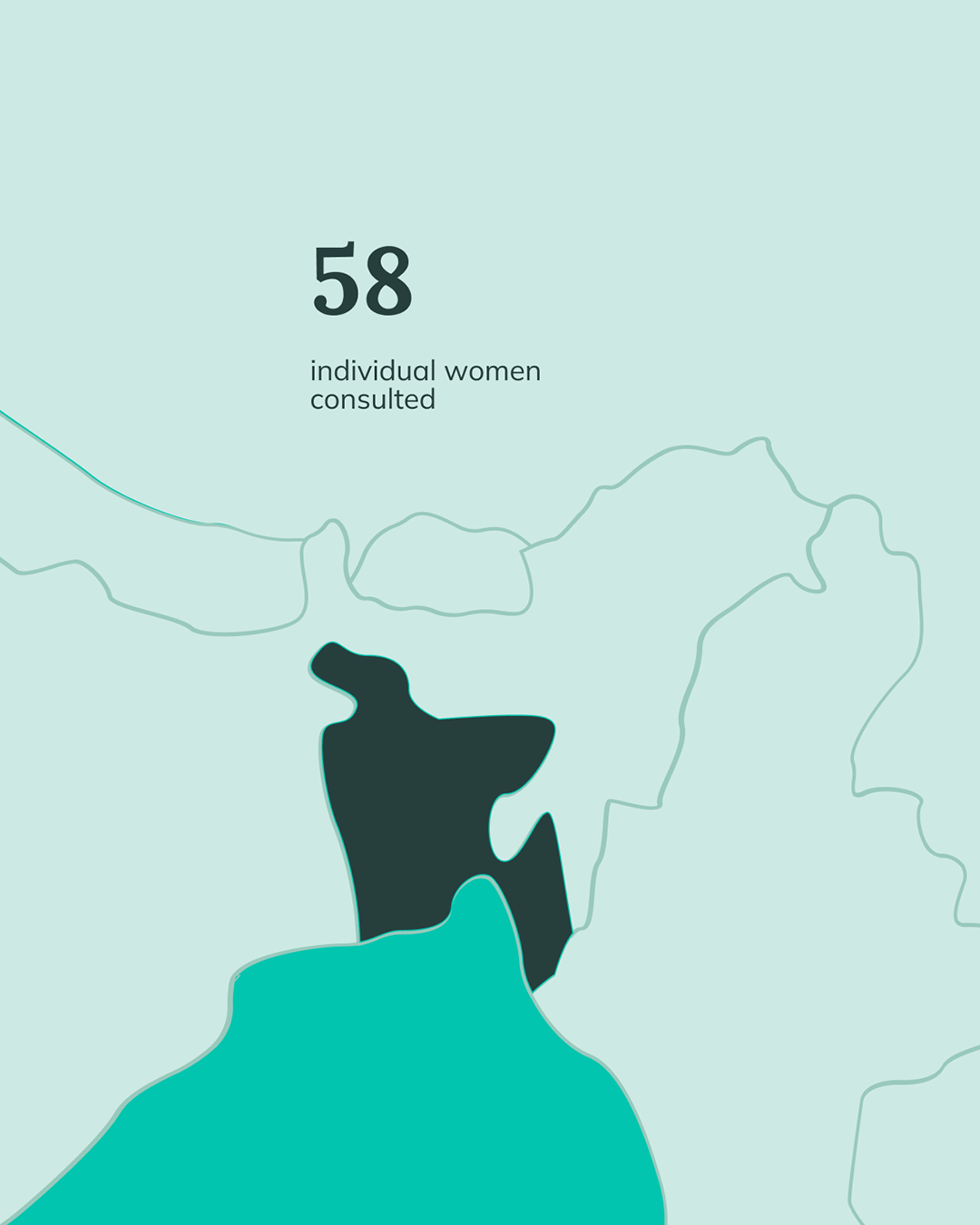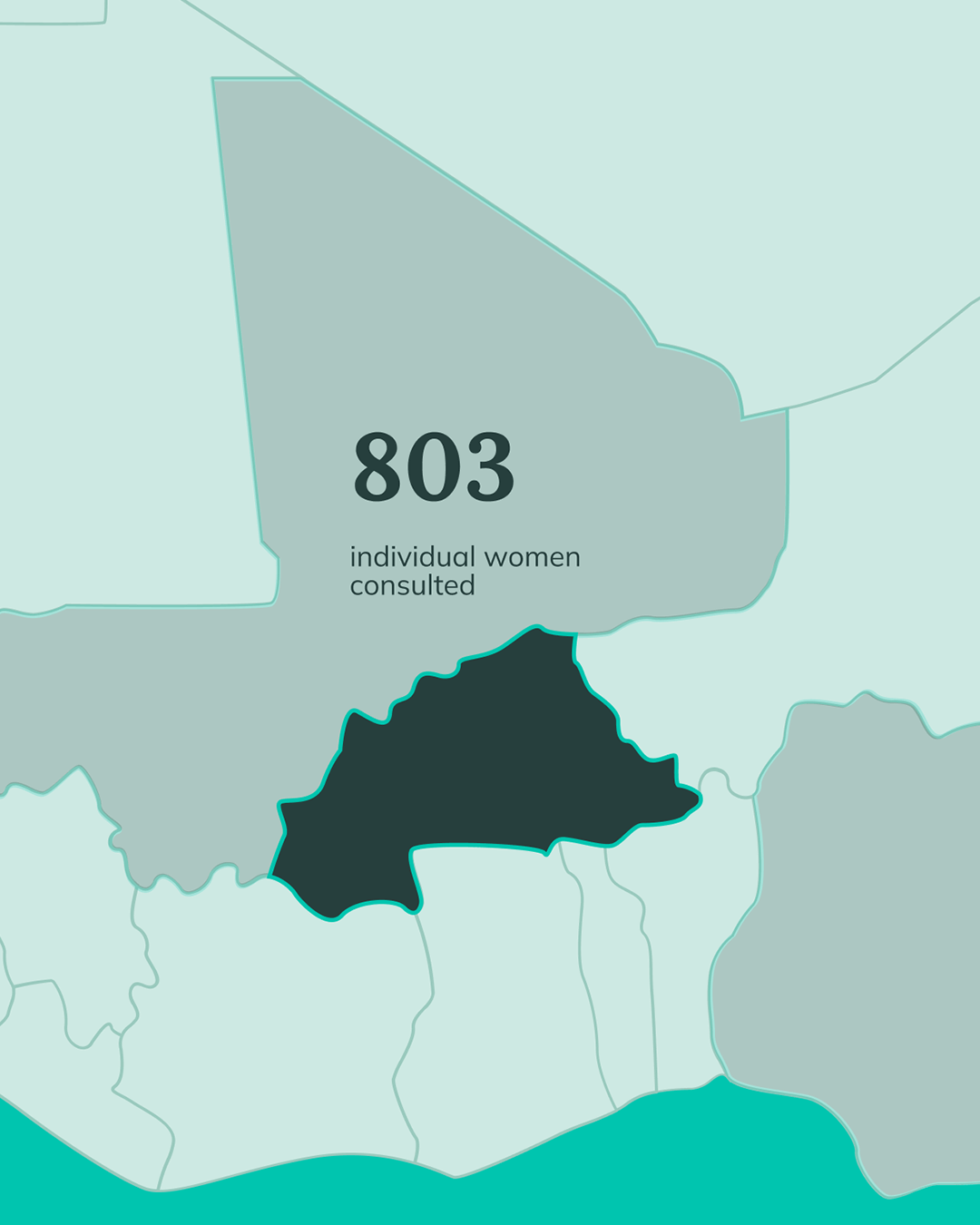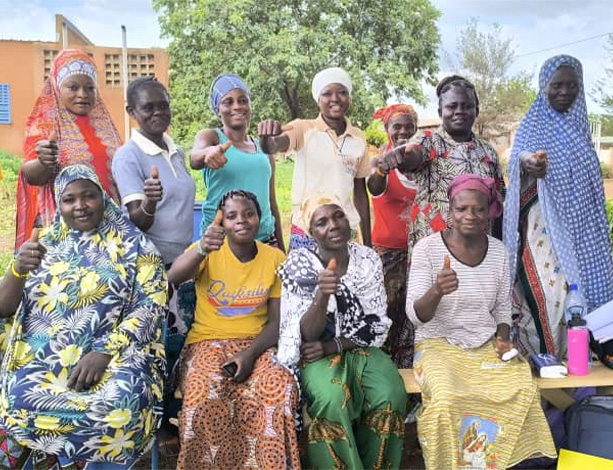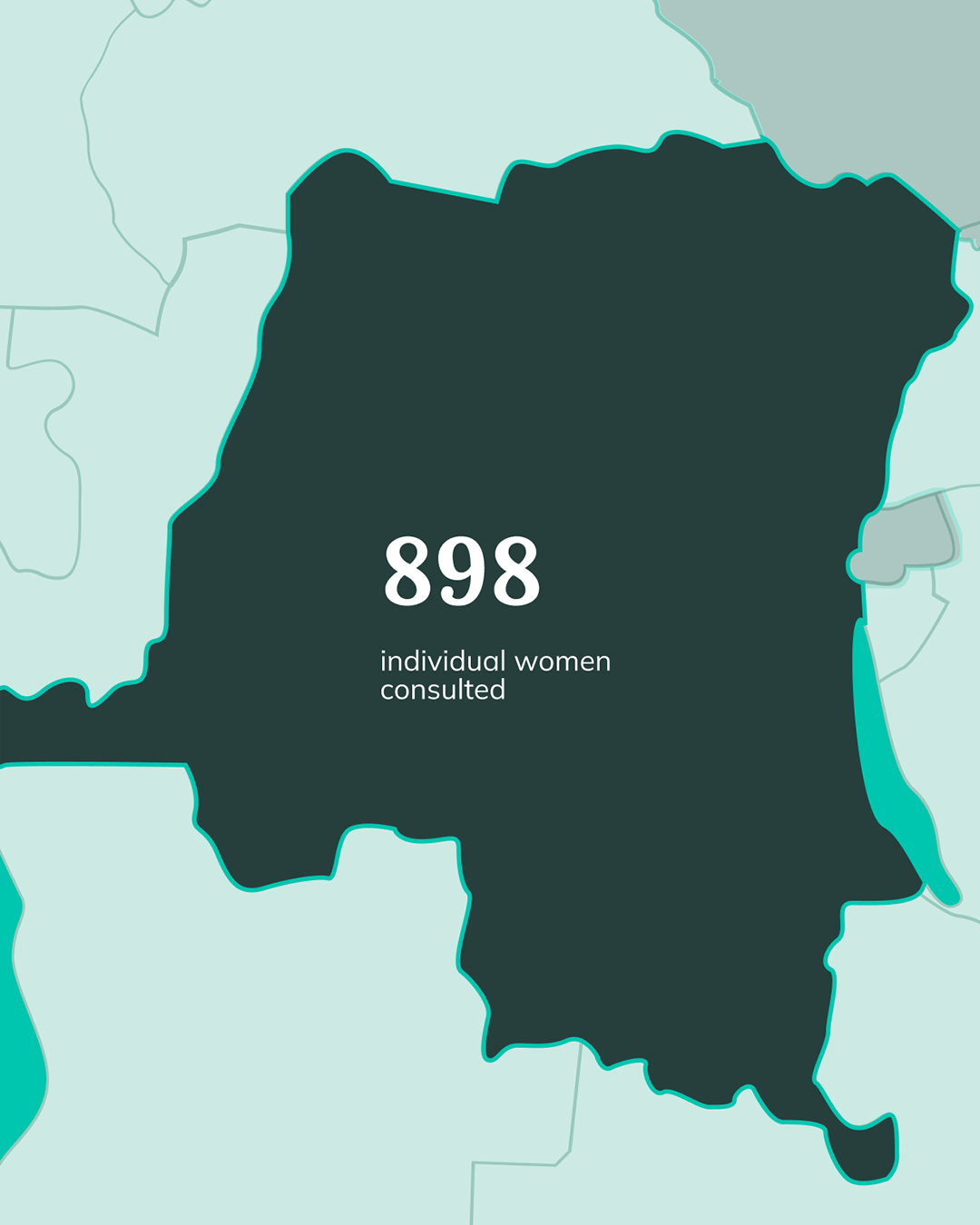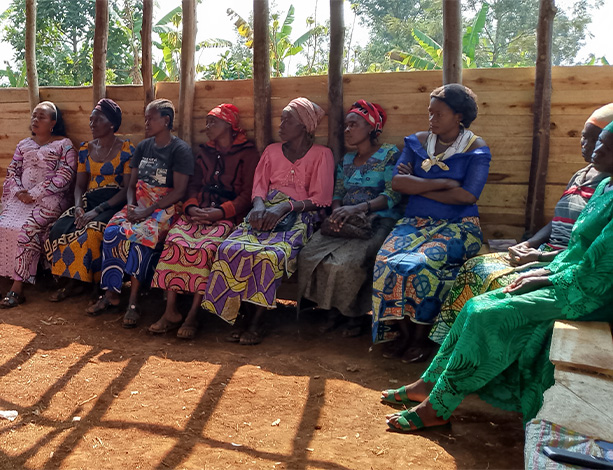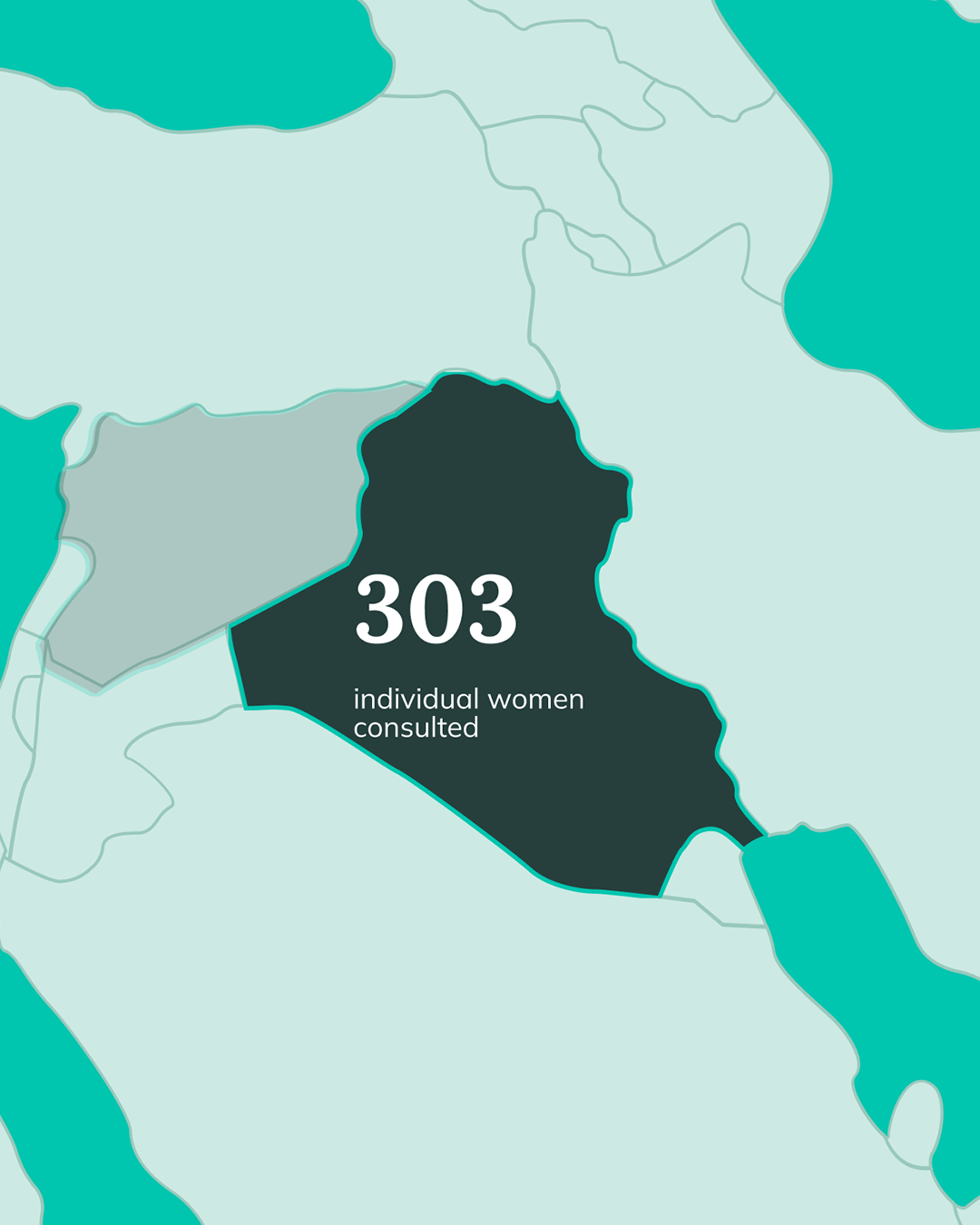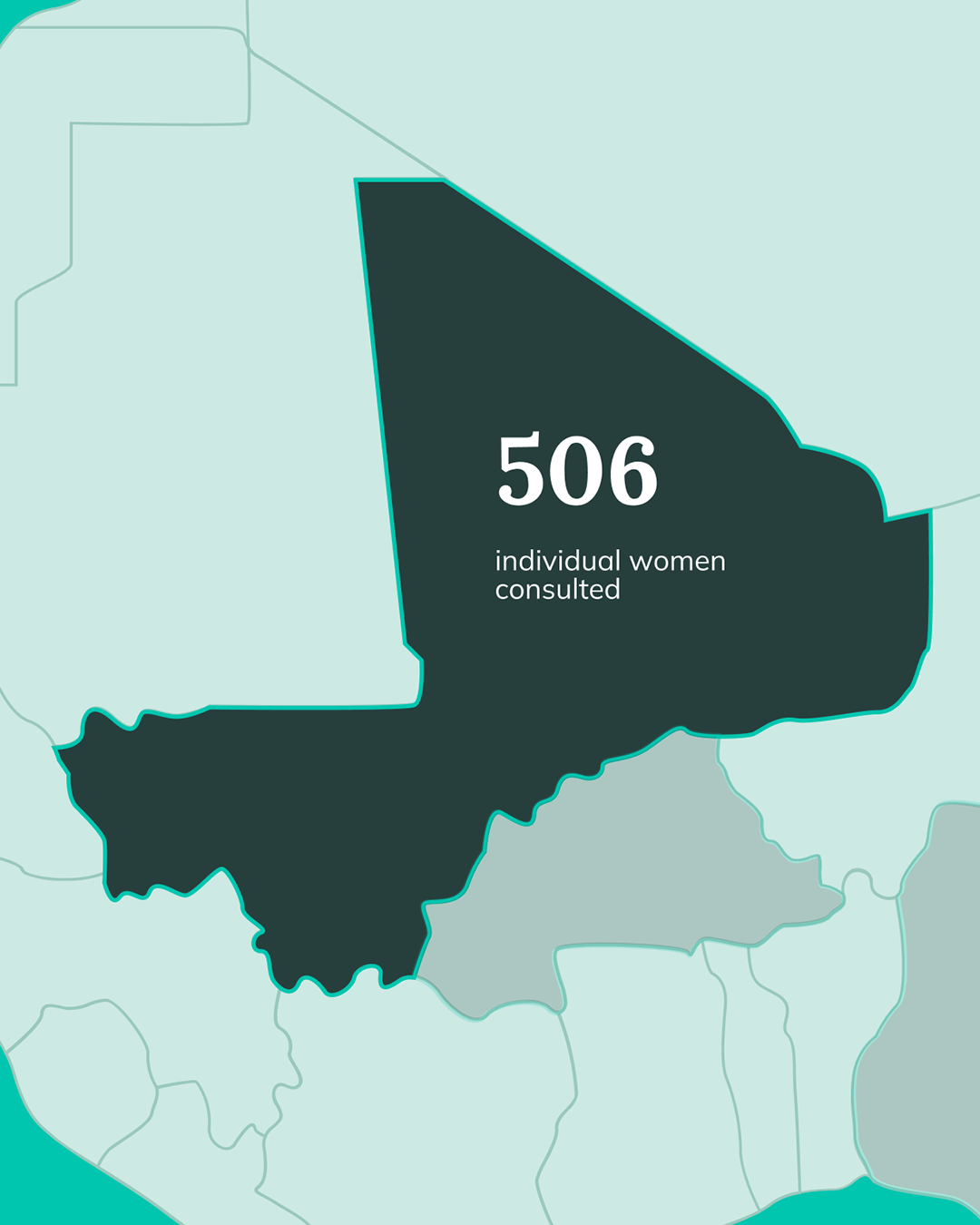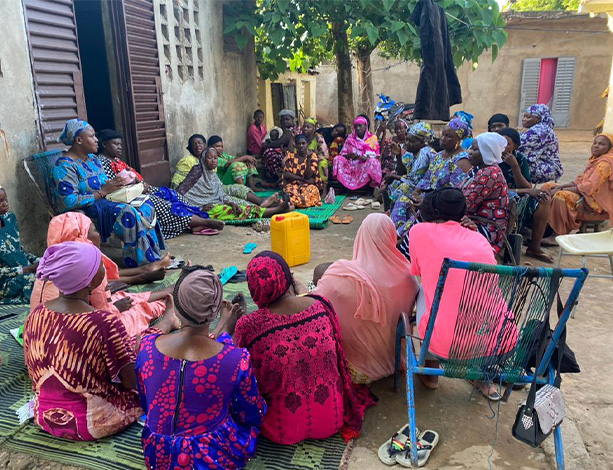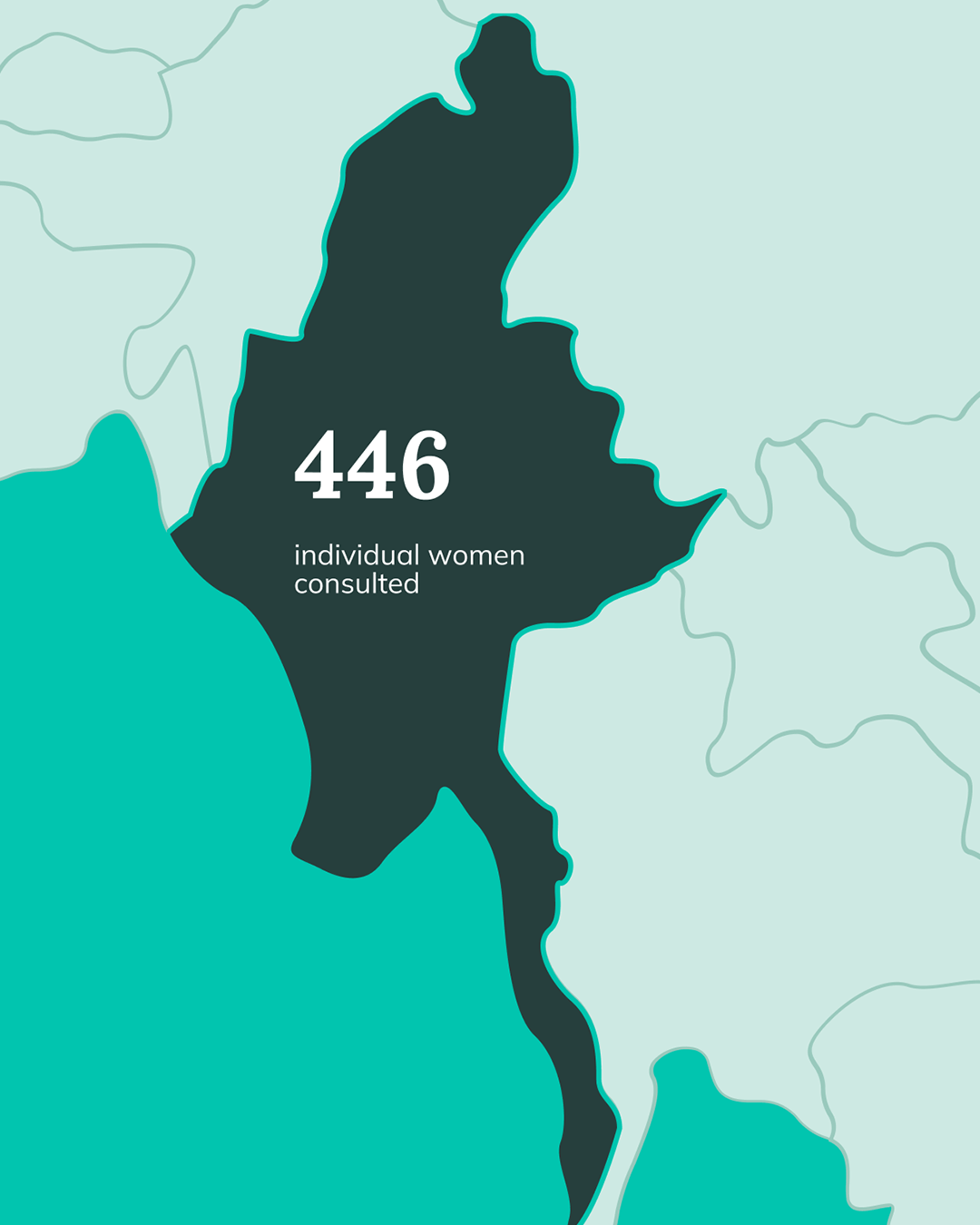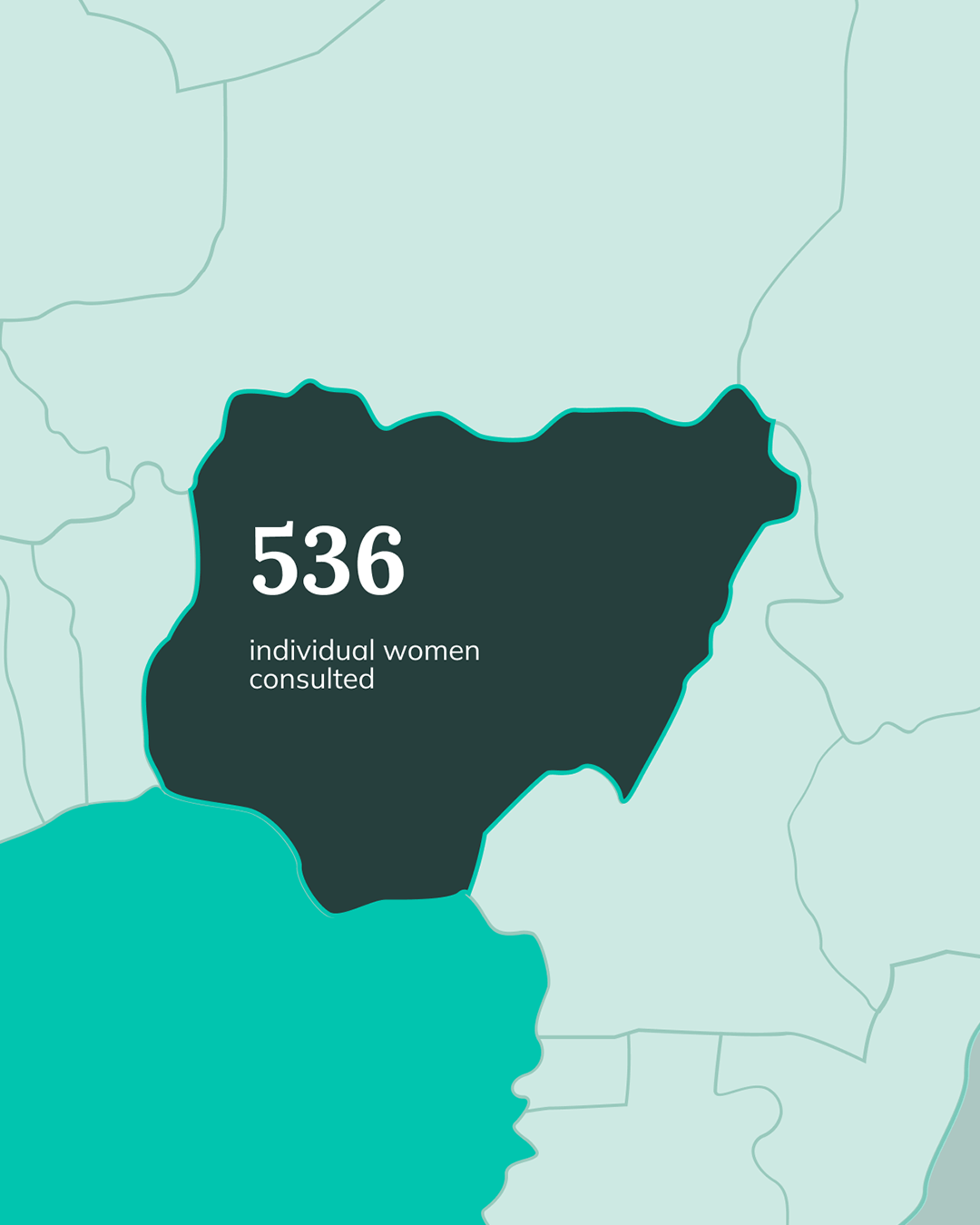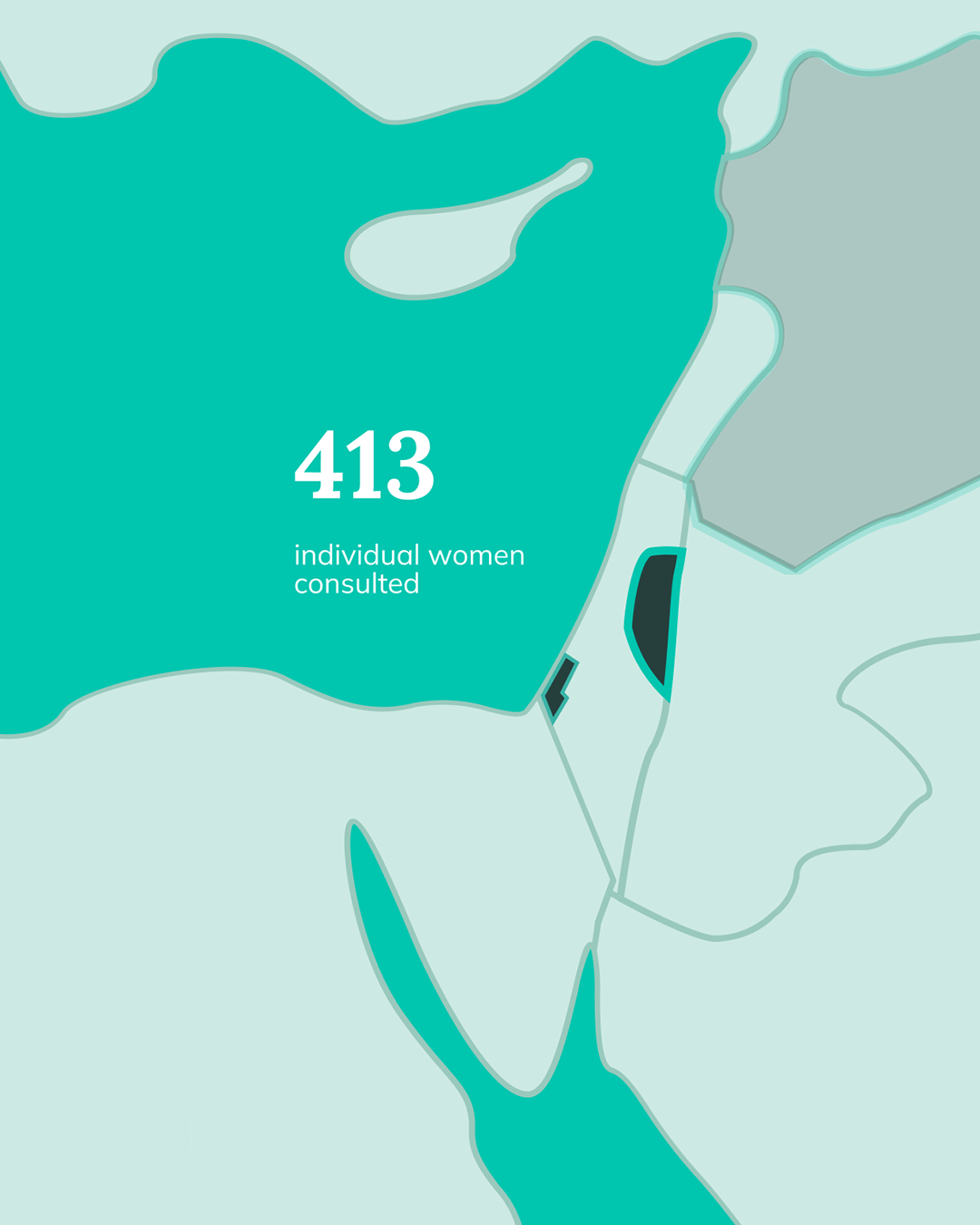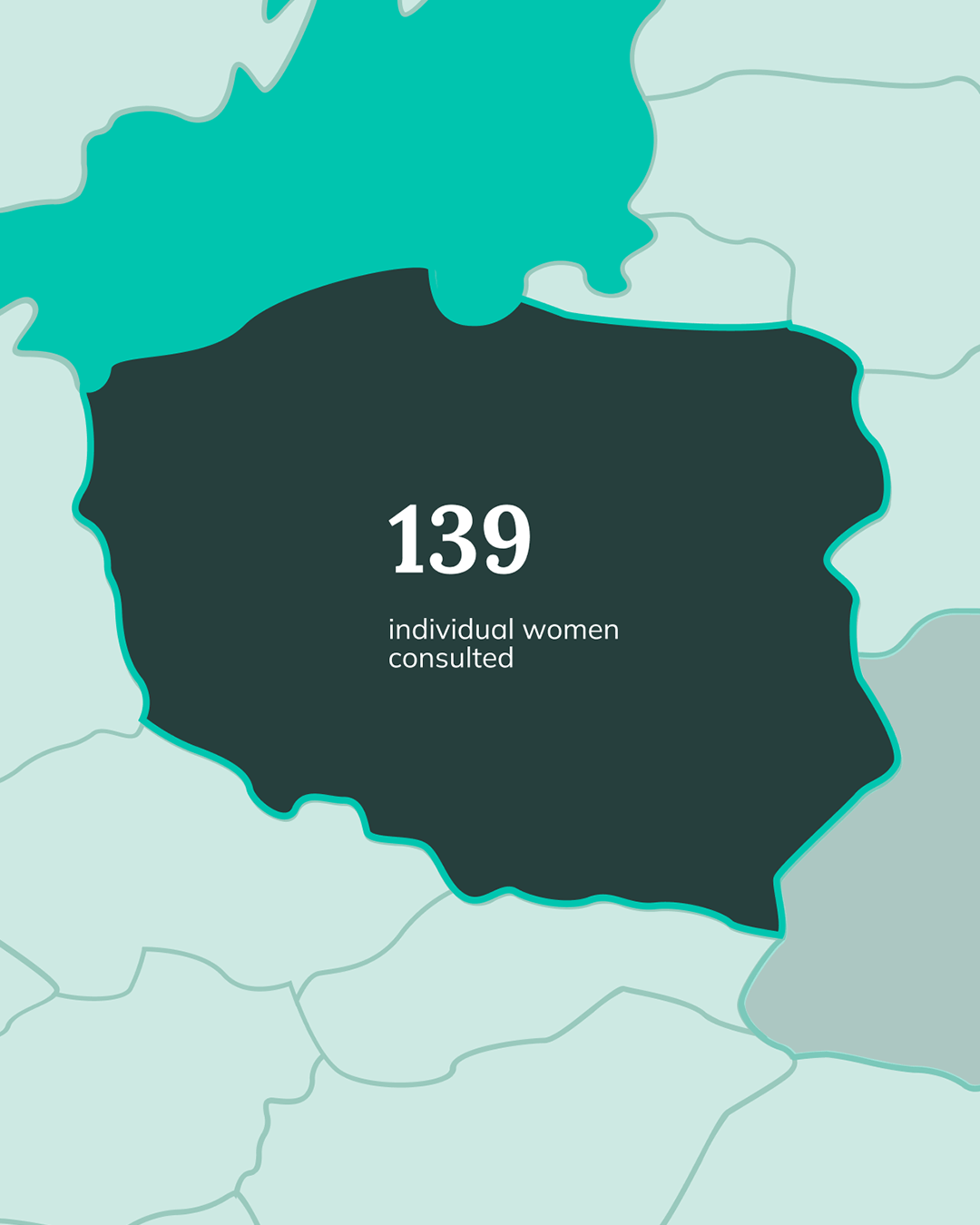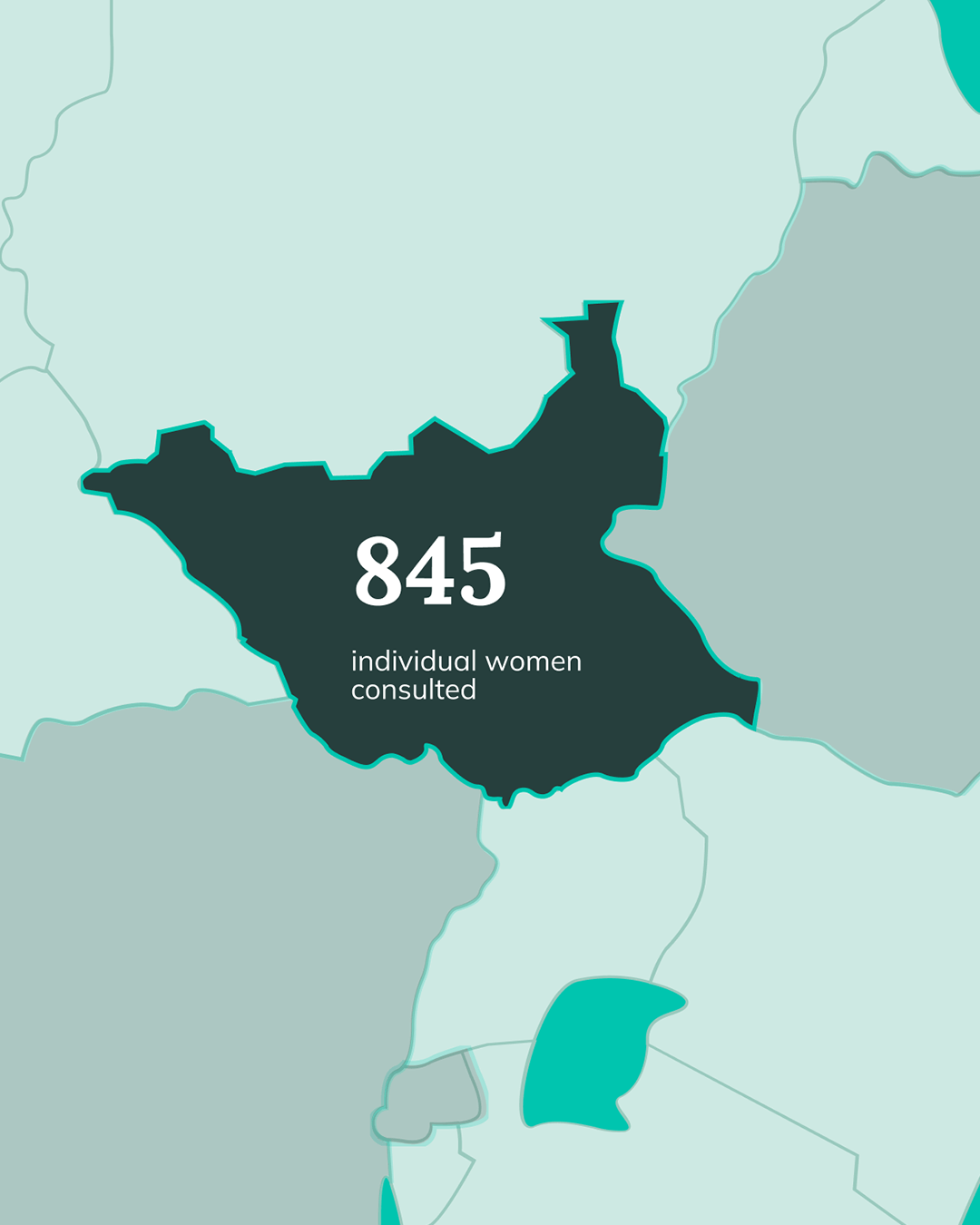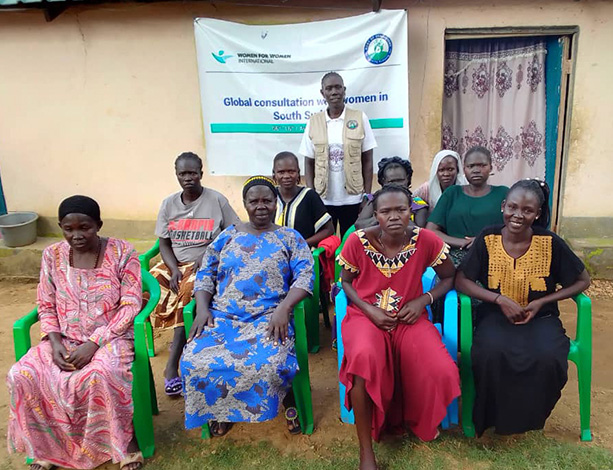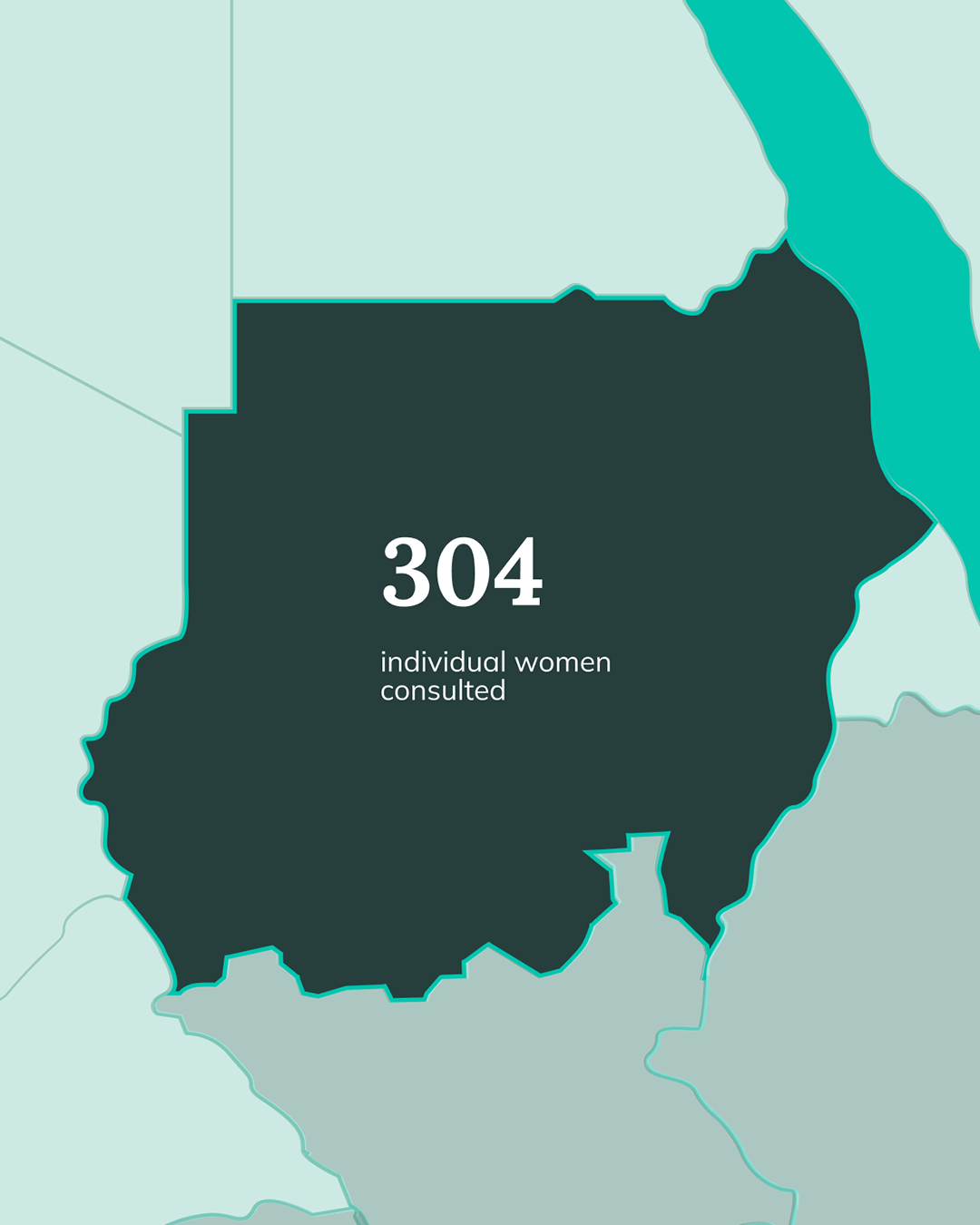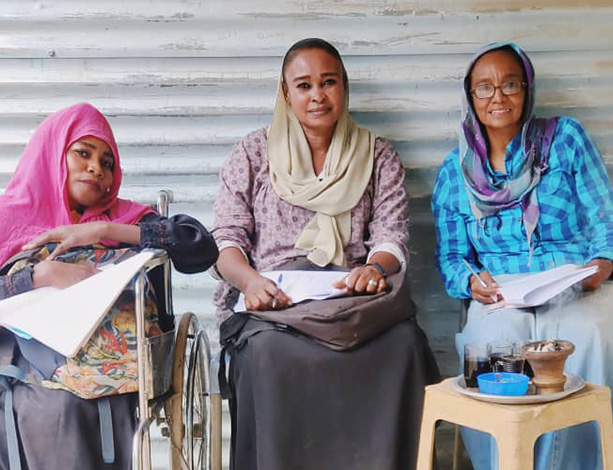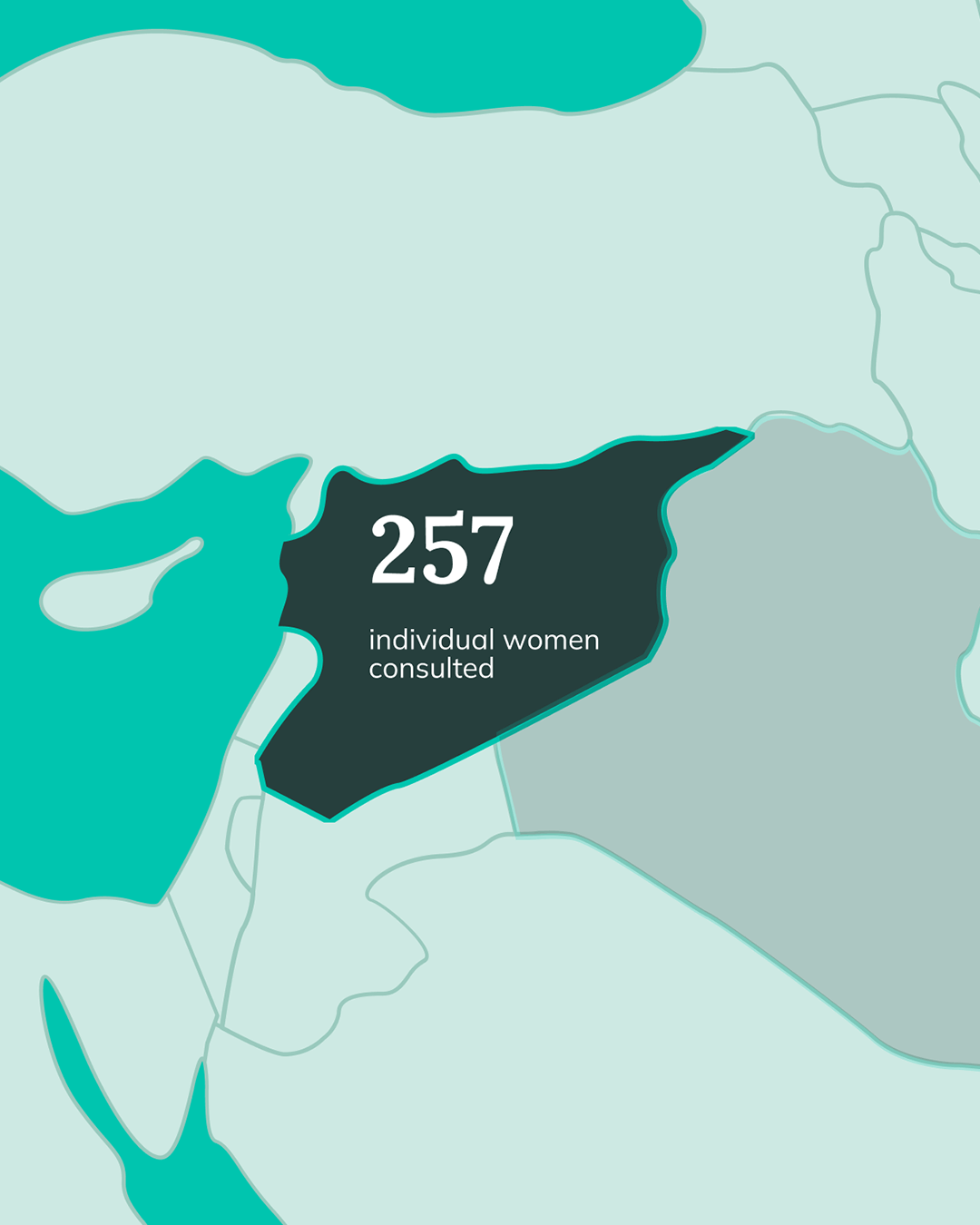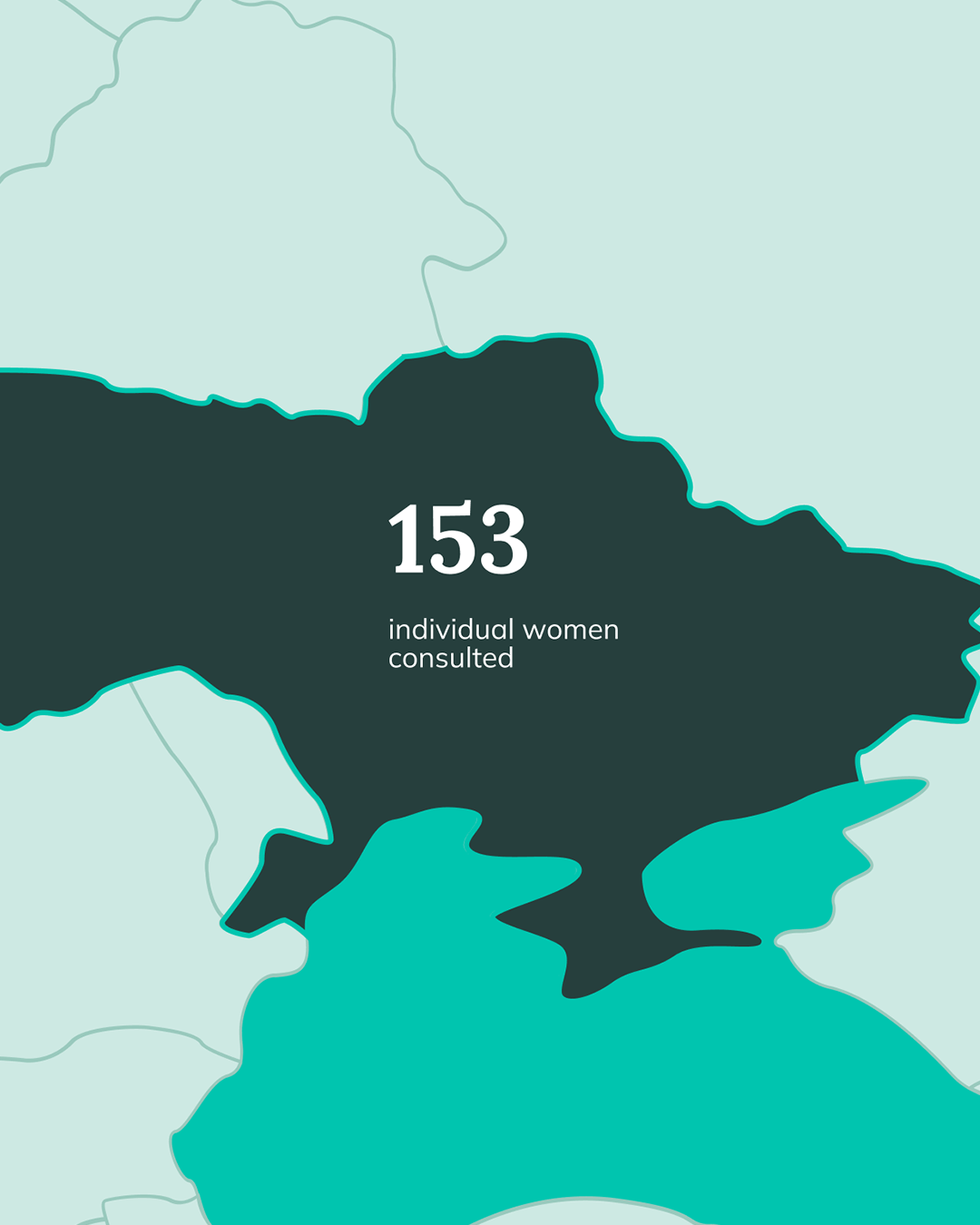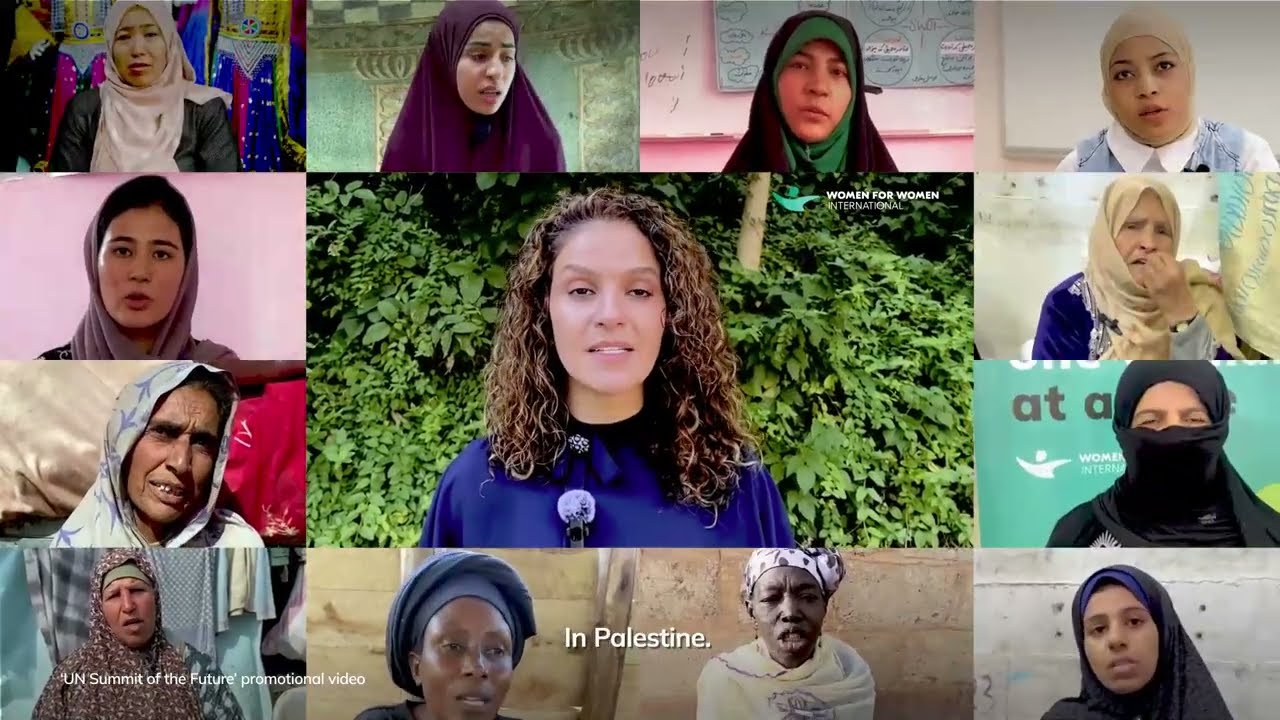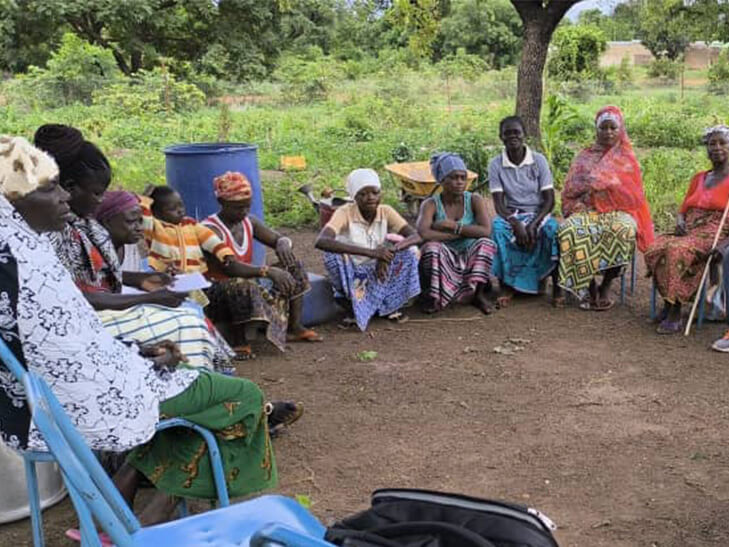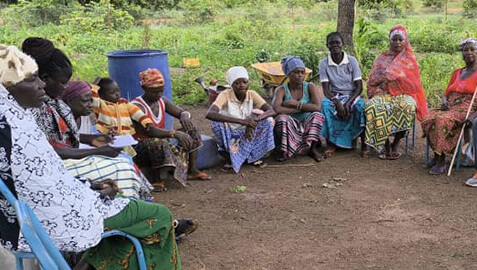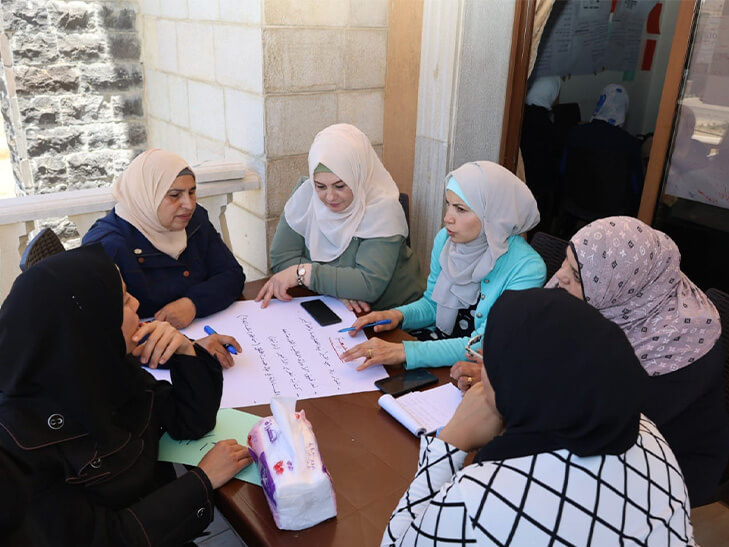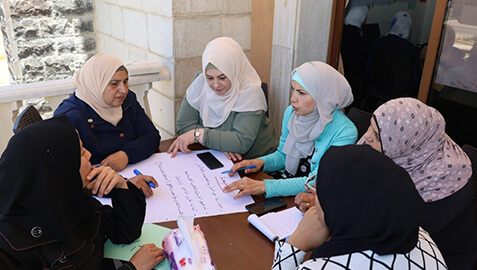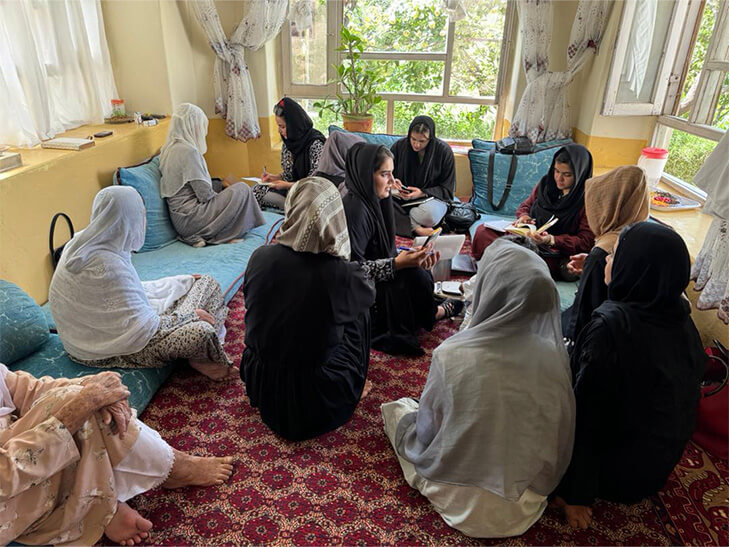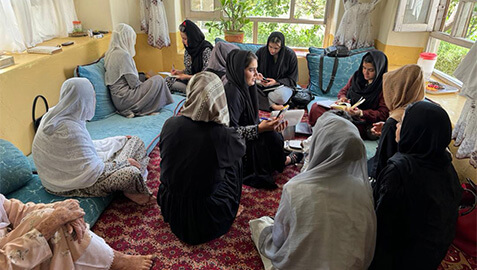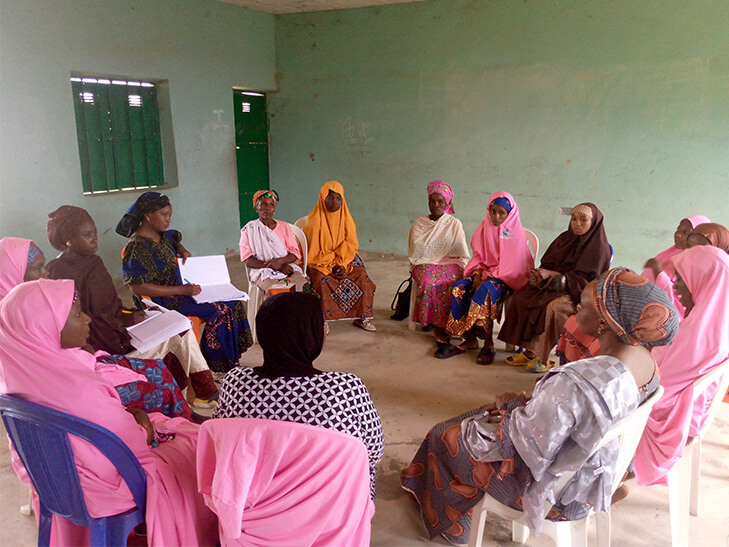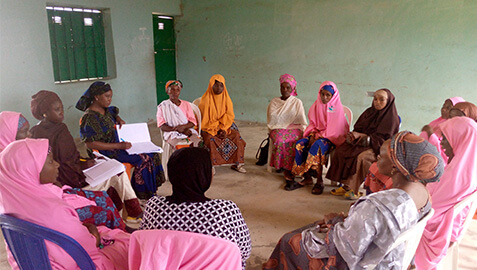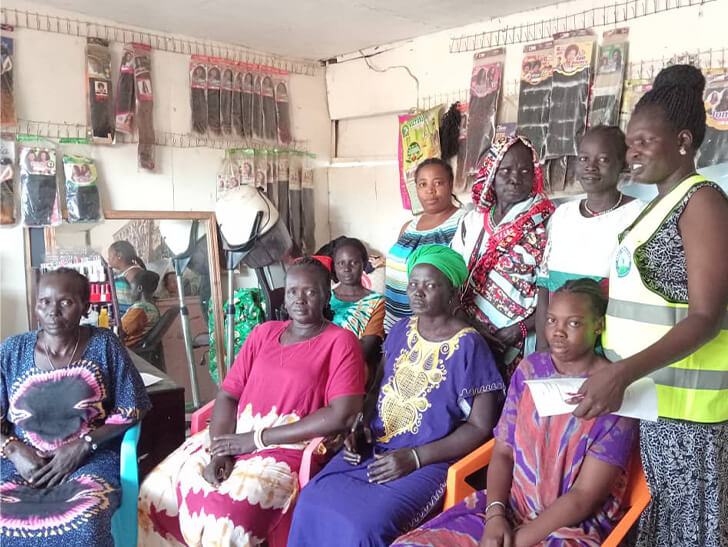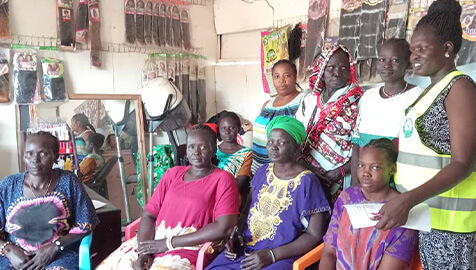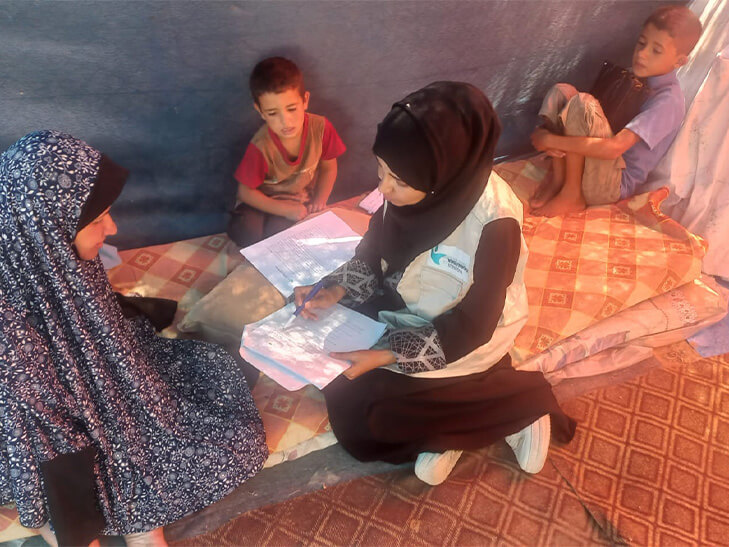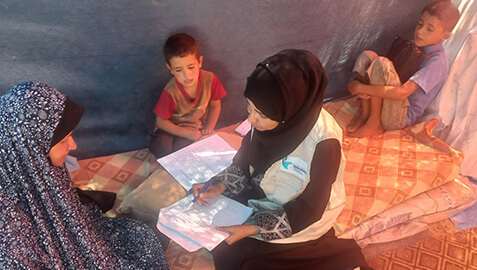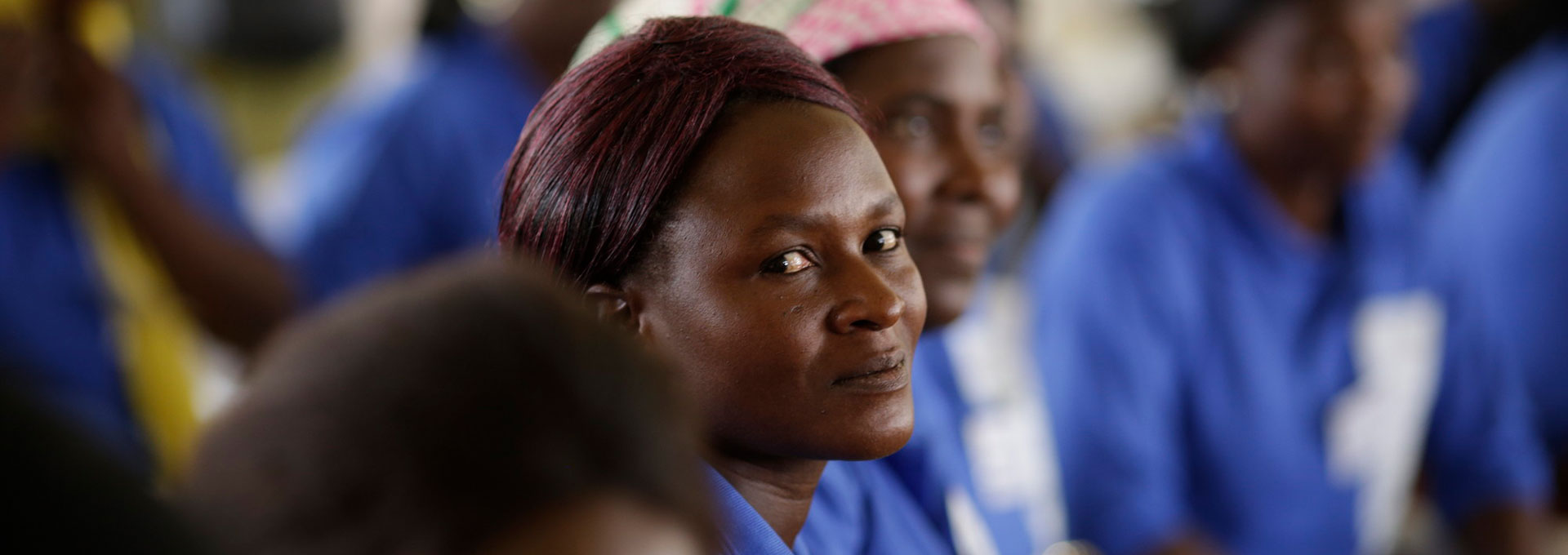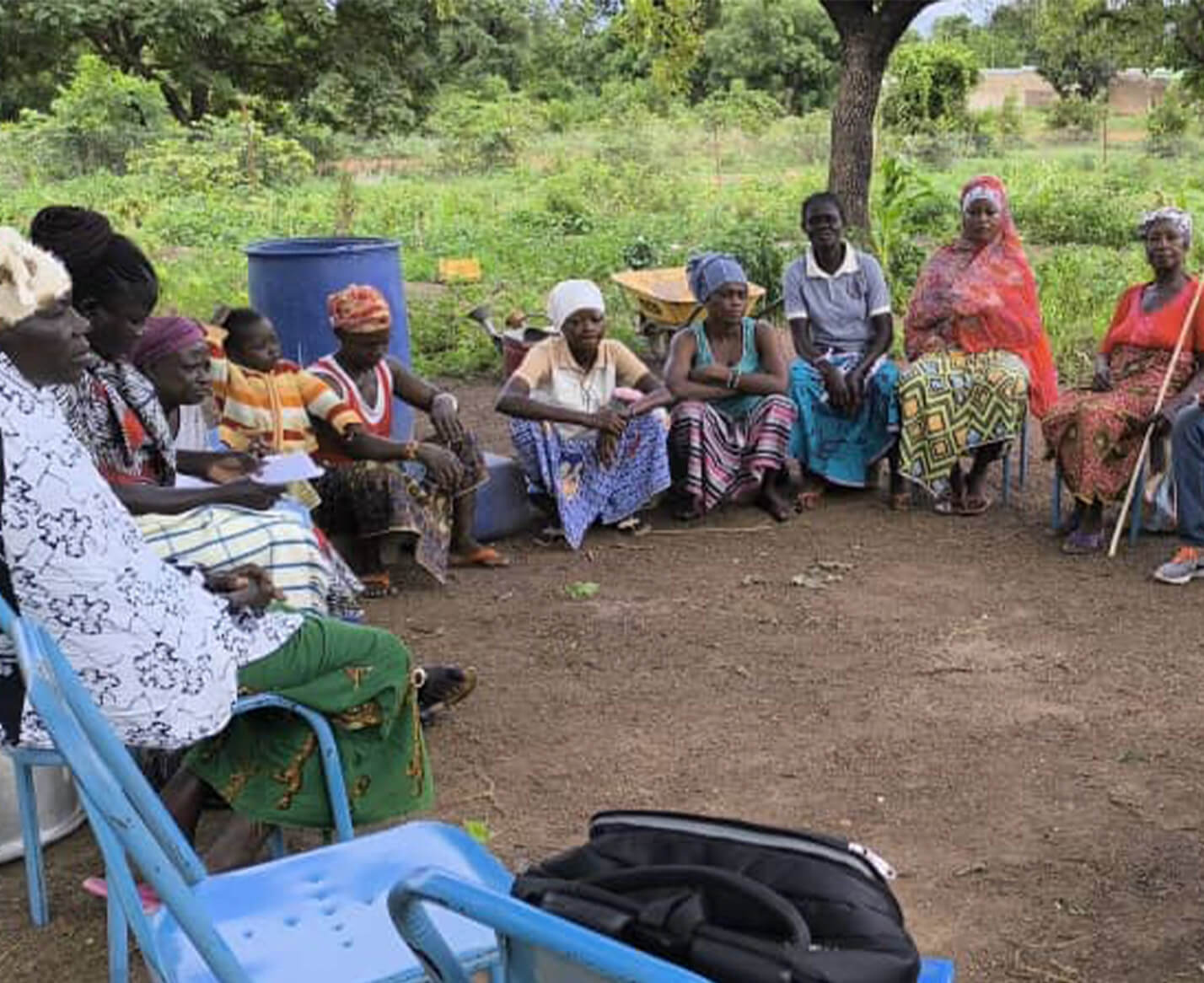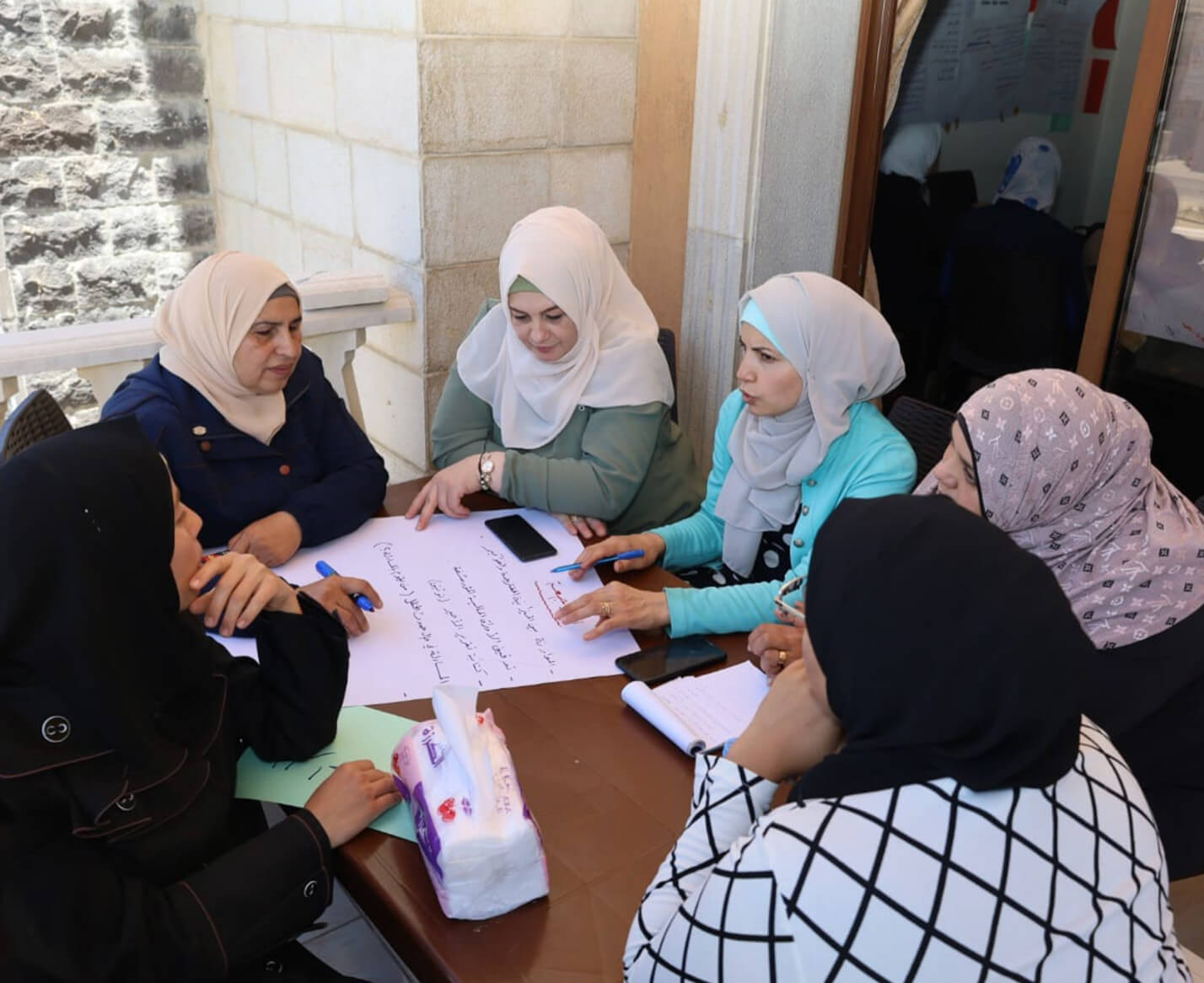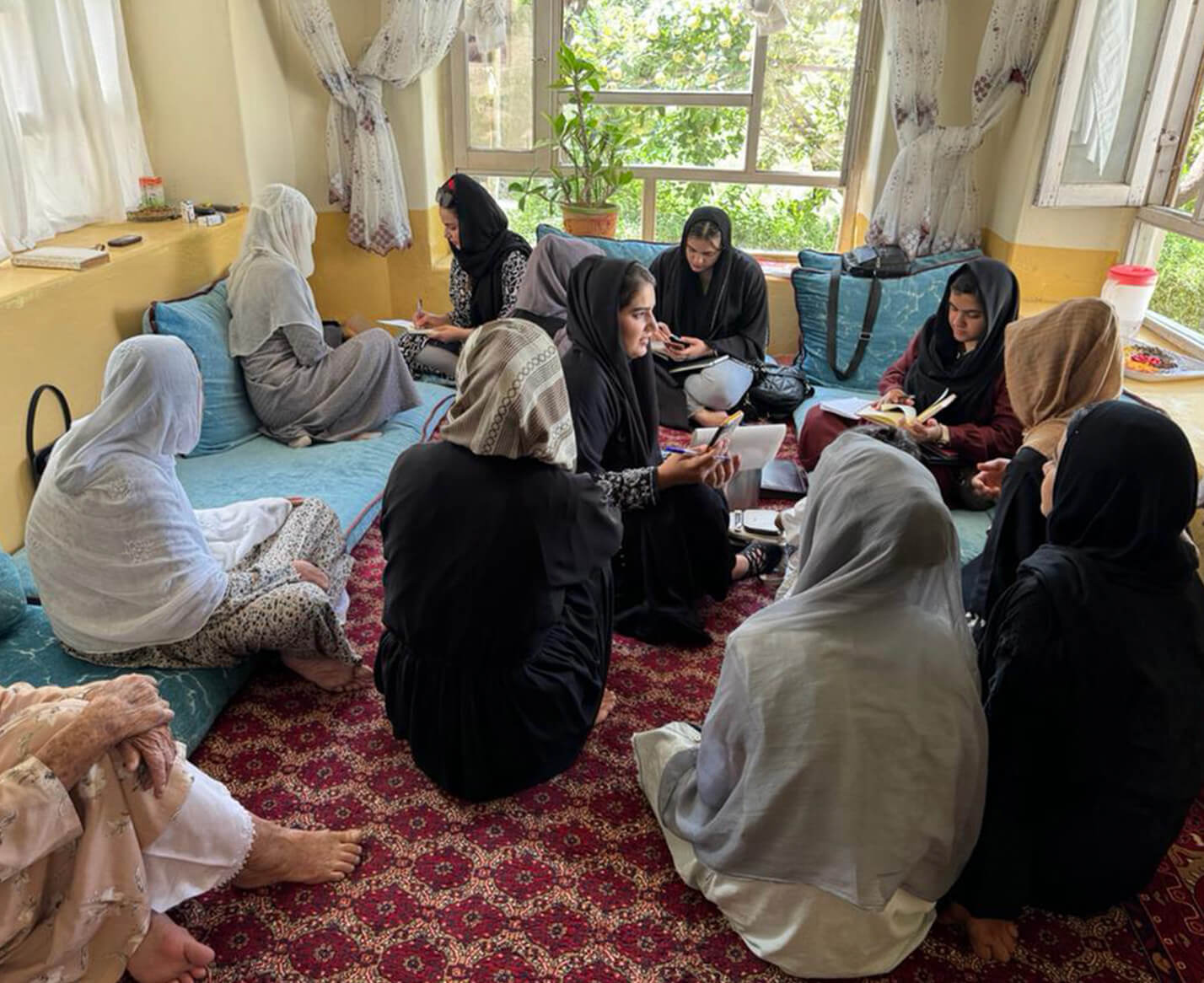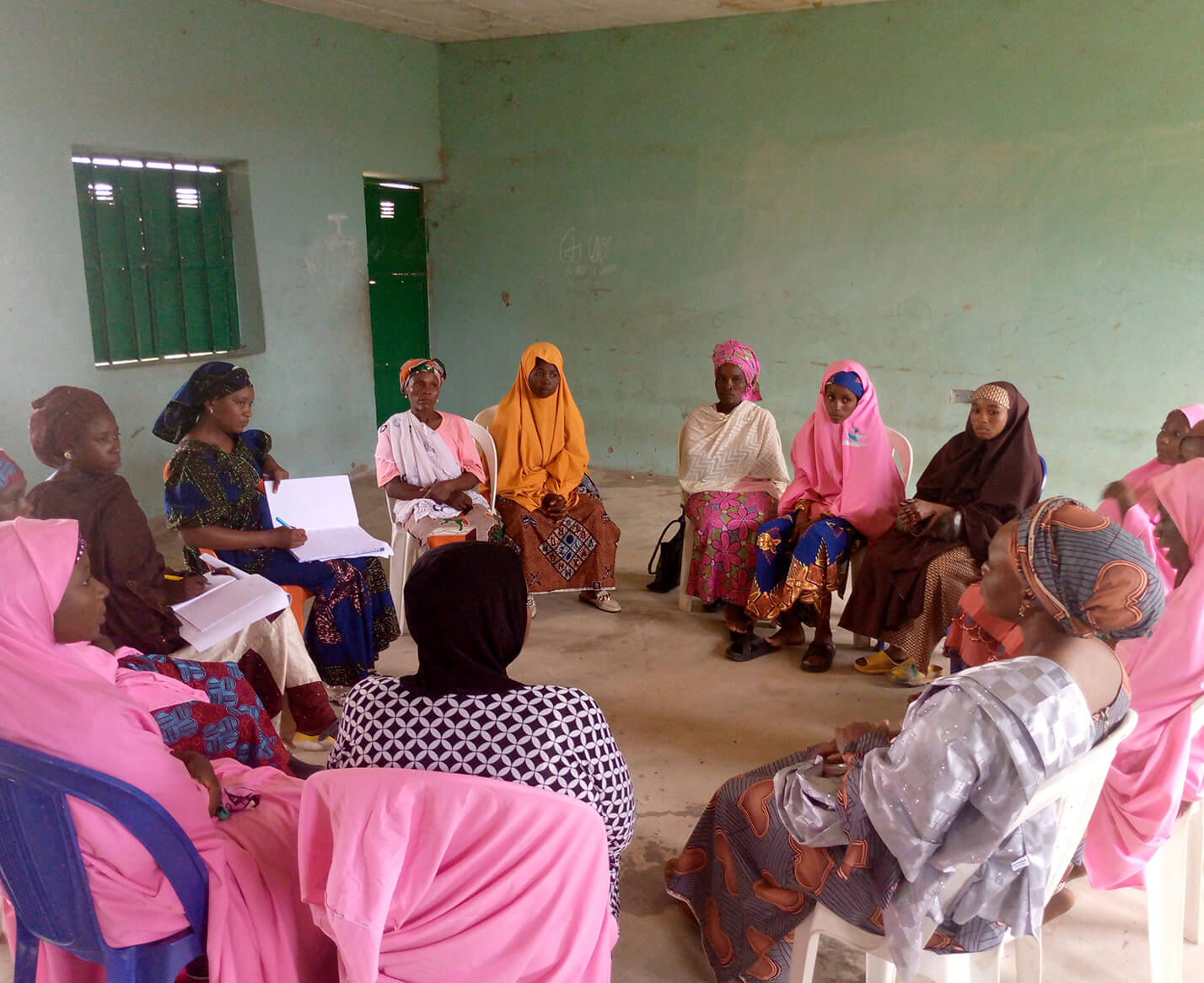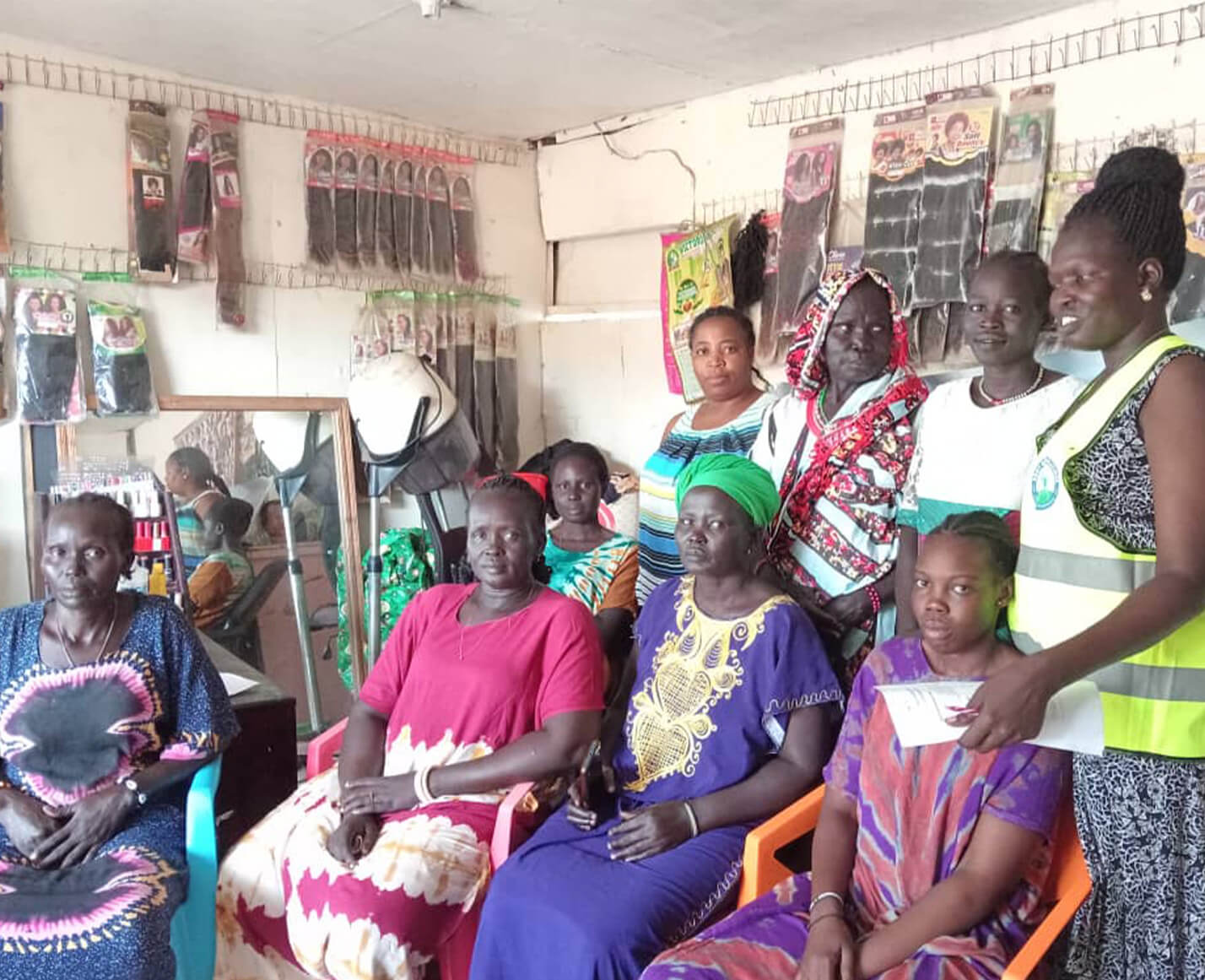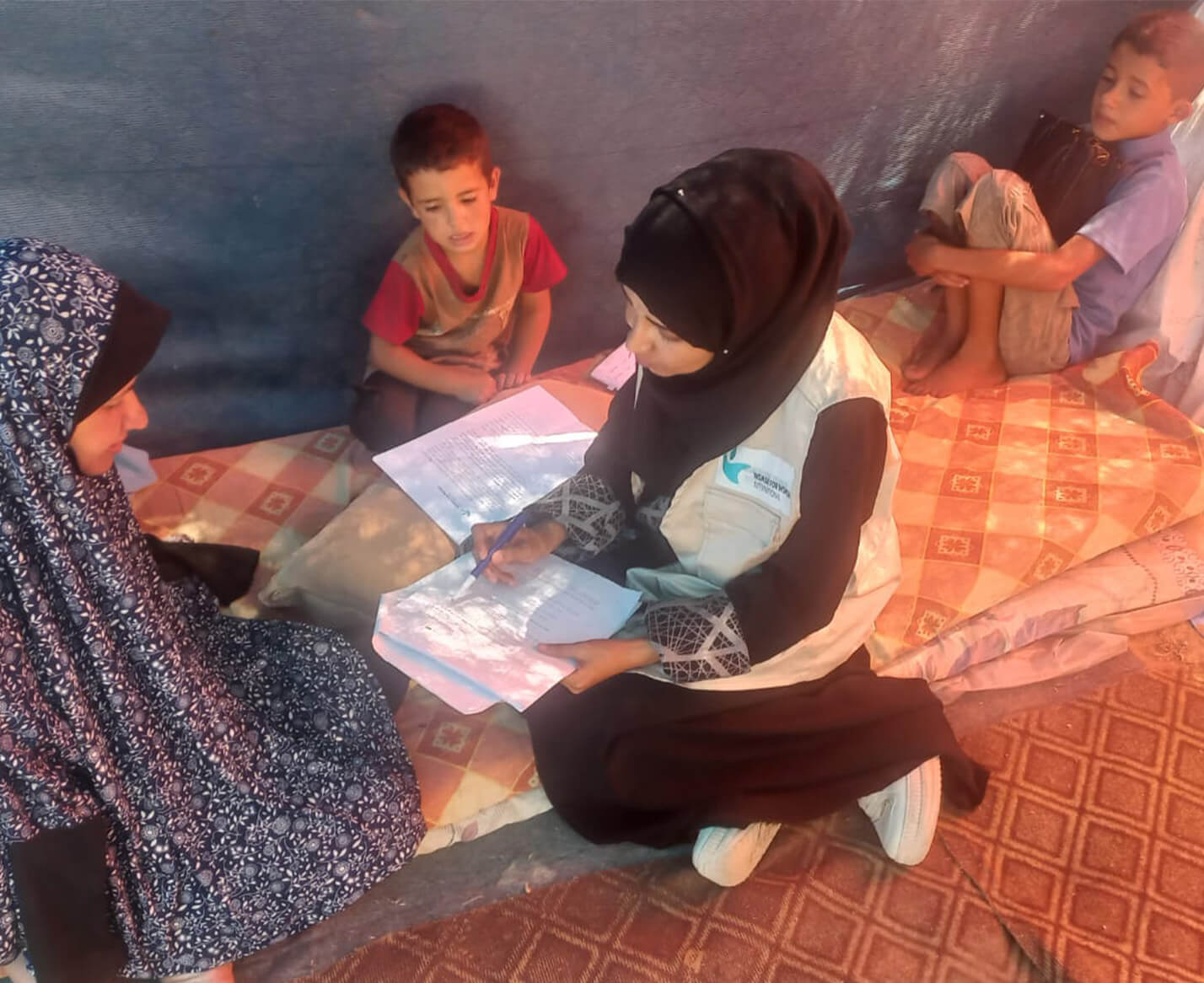Association pour la Promotion Féminine de Gaoua (APFG), Burkina Faso’
Who? Association pour la Promotion Féminine de Gaoua (APFG) Association for the Promotion of Women in Gaoua
Where do they work? In the south-west region of Burkina Faso
Contribution to ‘From Asking to Action’: Fed into the design of the consultation tools and consulted with a total of 200 women in Burkina Faso. This included collecting 100 surveys from their program participants in Burkina Faso and holding 10 focus group discussions with 100 women. The APFG team also participated in an in-depth interview about their work and approach to ‘meaningful consultation’.
APFG is no stranger to consultations. They involve women in the design and implementation of their organizational activities in each community where they operate so that women can be involved in identifying problems, proposing solutions, implementing activities through a women-led, community-based management committee, and then evaluating the programs together at the conclusion of each project.
Through being led by the priorities of the community, and of women in particular, APFG’s work has covered a range of issues relating to women’s rights and empowerment – for example, ending early and child marriage, improving access to education for women and girls, preventing female genital mutilation (FGM) and supporting women to access micro-credit to enable them to begin profit-generating activities. They do this through a variety of approaches, including capacity strengthening, training and awareness raising.
Women and girls themselves engage local authorities and traditional and religious leaders on addressing harmful cultural practices “community observatories” – an inclusive community meeting where the community invites community leaders or stakeholders to discuss topics such as conflict management, peace and social cohesion with women. Men and boys have also been supportive of APFG’s activities and have come on board as allies in promoting positive masculinity.
APFG operates at the intersection of harmful gender norms and the weakening of institutions and legal frameworks by conflict. They facilitate dialogues between men and women to change mindsets about a range of issues identified by women and girls themselves such as girls’ rights to education or women’s land ownership. In addition to cultivating male allies, they provide technical support to the justice system and institutions to ensure accountability for GBV cases. This holistic approach to addressing social norms and institutions has led to increased social awareness and support for tackling GBV and increased trust in the local authorities, which has encouraged more people to report cases of GBV.
APFG believes women can and should lead, and that the international community should listen to conflict-affected communities and let them define their own priorities. APFG also believes that working as a collective will achieve greater and more impactful results than individual organizations working on their own. To that end, APFG has helped to create and lead a regional network – the West African Network of Associations and NGOs Fighting Gender-Based Violence – consisting of 12 organizations based across five countries in West Africa (Cote d’Ivoire, Ghana, Mali, Senegal, and Burkina Faso). In the three years since the regional network in West Africa was formed in 2021, the members have been able to share best practices and innovative ideas on how to effectively combat GBV in their countries and communities while amplifying women’s voices and promoting their leadership.
Quotes:
“International NGOs need to be closer to women, and local organizations need more funding because they are closer to the beneficiaries.”
“We act as the spokespeople of the community – our strategies and mission are based on the wishes of the community.”
“Consultation must be participatory, taking into account the opinions of women at all levels and from all walks of life.”
Women Now for Development, Syria
Who? Women Now for Development
Where do they work? Syria and with Syrian women who have been displaced to Lebanon and Turkey
Contribution to ‘From Asking to Action’ project: Fed into the design of the consultation tools and conducted consultations with 257 Syrian women inside Syria via surveys. The Women Now for Development team also participated in an in-depth interview about their work and their approach to ‘meaningful consultations’.
“Meaningful engagement” is embedded within the mission statement of Women Now for Development (Women Now). Women Now is self-described as an organization which aims to engender the development of a society governed by democracy, freedom, and justice- a society where women have a meaningful role in everyday Syrian life. But what does meaningful’ mean to Women Now and the Syrian women they work with?
- Equitable – treats women as equal partners
- Context specific – is rooted in intersectional knowledge
- Conflict sensitive – considers protection and safety/security concerns
Women Now pursues its mission by advancing work across four main axes: protection, empowerment, political and social participation for women, and research and advocacy.
In Lebanon, Women Now piloted a community organizing model to inform their support for a local, women-led advocacy campaign to end child marriage. The leaders of this campaign were women formerly considered ‘victims’ – women who themselves were subjected to or affected by child marriage in some way.
This community organizing model then became central to their approach across all four axes in which they enable women to lead, starting with the project or campaign design and implementation of their initiatives, while also providing holistic support for the women leading change in each context. Women Now considers their main role to be supporting women with the tools they need to design and implement their strategies and the physical and metaphorical space necessary to identify the most important issues for their community and strategize together about the necessary steps to address them.
They often also support women in facilitating formal and informal consultations with women leaders in the communities or setting up meetings with the local municipality structures to mitigate the potential for possible backlash against the women’s campaigns.
Even in their emergency response to the 2023 earthquake in Syria and Turkey, Women Now engaged women as key actors in their crisis response. It was women-led initiatives that responded to the critical needs resulting from the earthquake in northwest Syria and women who coordinated distribution teams. By partnering with women-led initiatives, they were able to reach the most impacted geographic areas and groups within communities. Especially in places of complex acute and prolonged conflict and crisis, like Syria, it is critical to engage women not just as vulnerable, in-need populations but as key actors and leaders in crisis response.
Women Now plans to continue deploying this participatory methodology in its forthcoming campaigns to address gender-based violence (GBV) – particularly domestic violence – in northeast and northwest Syria. The plans are still in their early stages – so far, they know that the first step will be to give space to women who have been affected by GBV to lead the effort – not as beneficiaries but as campaign and project designers. Once the first step is complete, it will be these same women who tell Women Now what step two looks like.
Quotes:
“Women are not monoliths.”
“Before this methodology, the people – mainly women – were considered as victims, but here they are leaders.”
“The struggle for women’s rights cannot be separated from struggle for peace and democracy.”
“We hate the saying or the idea that we are the voice of the voiceless. Our main concern in the work is that we understand our different resources and privileges and we try always to use them to give the women we work with channels and platforms to own and just speak for themselves and on behalf of themselves, not us on behalf of them.”
“We have an approach that we’re working on and we have projects that we worked with, but it’s very crucial actually for this kind of work to be more flexible, to have more space to, to actually work participatory and no, the needs sometimes just knowing the needs before starting the project can we can meet with people, we can ask. Things are changing very fast -economic situations, political or social things are really not stable and I feel sometimes these restrictions really restrict us from working, and make our life more complicated, because it’s enough to work in such situation and it’s very overwhelming, so having flexible, supportive partners, supporters, donors, that’s one of the very important thing that always it’s needed.”
Kabul Orthopedic Organization, Afghanistan
Who? Kabul Orthopedic Institute
Where do they work? Afghanistan
Contribution to ‘From Asking to Action’: Consulted with 74 women in Afghanistan. Collected 50 surveys and held 2 focus group discussions with 24 women. The Institute’s team also participated in an in-depth interview about their work and approach to ‘meaningful consultation’.
The Kabul Orthopedic Institute is an Afghan welfare NGO that runs various activities including orthopedic workshops, physiotherapy services, physical rehabilitation services, enhancing the professional knowledge of its employees, and building and maintaining strong relationships with domestic and international institutions. It focuses on women and children living with disabilities to help them to reintegrate into society despite the significant challenges they face both due to gender and disability.
The Institute has successfully supported many individuals with physical disabilities, of whom 70% are women and children. Providing health and rehabilitation services to women with permanent and temporary disabilities enables them to eventually achieve independence in their daily lives, contribute to their families’ livelihoods, and overall aid in Afghanistan’s development as active members of society.
Women are actively involved in delivering the Institute’s services and play a significant role in assisting their peers. This makes women more comfortable in receiving them. Women are also directly involved in designing and implementing the Institute’s activities at various levels, from leadership to indirect contributions through evaluations and feedback.
The Kabul Orthopedic Institute is led by women who are active members of women’s rights organizations and who work toward the protection and promotion of women’s and girls’ rights through advocacy and awareness-raising activities, such as educational programs. Their efforts are aimed at preventing violence against women and girls and ensuring that women and girls receive some form of education despite current restrictions on women and girls pursuing secondary and higher education.
The Institute has had its fair share of challenges operating in the current political environment in Afghanistan, following the Taliban takeover in 2021. Harmful political and socio-economic factors, which were already existent before the Taliban takeover, have limited opportunities for women’s participation and empowerment in the country. In addition, the de facto government has created various challenges for women, exacerbating violence and failing to uphold women’s rights. Instead, women’s rights have been severely curtailed in various aspects of their lives, further reducing the chances for women to realize their full potential and earn a livelihood.
The Institute has also faced interference from the de facto government through restrictions on its female staff working there. However, there could be a sliver of hope for women and girls through the inclusion of men and boys in programs. Men and boys play a significant role in the Institute’s activities as important collaborators in preventing or responding to violence against women and girls.
Regarding meaningful consultation and inclusion of women, the Kabul Orthopedic Institute believes that consultations with women should be straightforward and friendly, using local and national languages to effectively communicate. In its experience, group consultations often yield better feedback as women feel more free to express themselves. However, the de facto government does not permit such activities openly due to restrictions. Therefore, consultations are conducted discreetly, demonstrating the determination of the Institute to engage women meaningfully in its activities and programs. The Institute calls for opportunities to be provided to women, for women’s opinions to be respected, and women – including women with disabilities – should be meaningfully included in society with significant roles and contributions.
Quotes”
“Raising men’s awareness about women’s rights and respect is fundamental to finding a solution.”
“Aid programs should be inclusive, meaning that women must be involved in the design and implementation of these programs to ensure better support for them.”
Change Agents, Nigeria
Who? Change Agents in Nigeria
Where do they work? Plateau State, Nigeria
Contribution to ‘From Asking to Action’: Participated in consultation design workshops to inform the design of the project’s scope and the research tools.
Women for Women International has a network of over 1,300 Change Agents whose expertise has been leveraged throughout “From Asking to Action” to inform the design, facilitation, and outcomes of this consultation. Change Agents are women who demonstrate a motivation to create change in their community and then participate in advocacy and leadership training led by Women for Women International. Through these trainings, women become community advocates and leaders who can identify the changes they want to see and create action plans that outline how they want to use their voices and experiences to influence changes in their communities.
At the outset of the From Asking to Action project, we organized participatory design workshops and interviews with Change Agents across four countries – encouraging them to shape the scope, key questions, methodology and targeting of the consultation. Through their participation in the design, Change Agents in Plateau State Nigeria shared that women in Nigeria are facing a myriad of intersecting barriers to their rights including: domestic abuse, girl-child trafficking, the denial of girls’ education, ongoing conflict, forced marriages, the lack of women’s inclusion and participation in decision-making and leadership and the denial of women’s access to their land and assets. It is within this context that Change Agents in Plateau state have been collectively advocating for change with their local decision-makers.
Change Agents shared that they often face challenges within their families for engaging in economic activities or public decision-making processes that are perceived as being outside their gender role. However, they see the importance of persistence and participating in community dialogues and advocacy campaigns that aim to promote peace and security. For Change Agents in Plateau State, legal structures, such as court hearings in particular, are an important decision-making space to advocate within. This is because formal decision-making structures increase the visibility of women in traditionally patriarchal settings and provide an official opportunity for Change Agents’ expertise and priorities to be listened to.
For example, participants at the FGD shared how they’ve advocated for their inclusion in local court hearings to contribute to community peace thought conflict prevention on land dispute issues:
“There is a boundary community between Rim and Riyom where the community people farm although it always causes disputes between the two communities claiming the land. The case was then taken to court, yet the dispute continued. I advocated that since the case began in court, only men always attend court hearings, so why not go along with at least one woman to the court hearing as she will have one input or the other? I advised that the land be left unfarmed until the court case is finalized. The Chief listened to my advice and the dispute arising from the land matter ceased until the court case is sorted.” (Change Agent, FGD in Plateau State)
Change Agents in Plateau State shared that denial of asset control and ownership was the most significant way in which women in their community were impacted by gender-based violence. This makes this example of Change Agents being recognized by their local chief on an issue of asset and land control all the more important as it shows how Change Agents are mobilizing on the issues that are most impacting their communities to slowly move the dial on their inclusion in future decisions that impact peace within their communities.
So, what recommendations did the Change Agents have for ensuring that “From Asking to Action” does not miss the most marginalized women? = Simple – make a conscious effort to reach those communities. This must be intentional and might include home visits or relationship-building with the associations and local groups that those women interact with, such as cultural or religious groups.
Change Agents in Plateau State continue prioritizing this participatory approach to ensure that the priorities, challenges and lived experiences of the most marginalized women in their communities are amplified with their local decision makers.
Quotes:
“Initially, my husband did not support my economic activity, but I persisted and now I supported my daughter through school, up till Polytechnic and he is so proud of her and boasts that he has a daughter who graduated from the Polytechnic.” Zara (Pankshin)
Root of Generations, South Sudan
Who? Root of Generations
Where do they work? South Sudan, across all ten states, with a support office in Juba and field offices in Eastern Equatoria State and Central Equatoria State
Contribution to ‘From Asking to Action’: Root of Generations consulted with a total of 589 women in South Sudan, including by South Sudanese women and Sudanese refugee women. This included collecting 479 surveys and holding 12 focus group discussions with 110 women. The Root of Generations team also participated in an in-depth interview about their work and approach to ‘meaningful consultations’.
Root of Generations (RoG) is a South Sudanese national NGO founded to instill in the minds of communities the strength and value of women and advocate for equal treatment, value and respect to both sexes. RoG inspire women, girls, boys, men and communities to believe in women’s aspirations and capacities through offering education and professional development. Meaningful participation is built into its organizational structure, programming, and advocacy.
In a country that has experienced armed conflict since its independence, and where harmful cultural practices and norms still run deep within its society, Root of Generations works to break the mirror through which society sees women, ensure that women are heard and valued, and that their experiences and recommendations are taken seriously. Cultural practices such as child marriage, women being relegated to household matters, and not owning property are pervasive, meaning it takes a great deal of time and effort for these to be addressed.
RoG’s work is long-term, whole-of-community, and aimed at dismantling the root causes and institutional challenges preventing women from realizing their rights. But it is not without its challenges. Intimidation and harassment by government and security agencies challenges the advocacy work of the women supported by RoG. This is why safe spaces are central to RoGs approach for overcoming some of these barriers to women’s meaningful participation and for supporting and empowering youth, gender-based violence (GBV) survivors, and socio-economically vulnerable women and populations. Spaces are created specifically for women to come together, discuss issues important in their daily lives, and build the necessary confidence to lift up their voices in society. Women also use the safe spaces as an advocacy venue where they identify one issue and advocate for it to the leadership at the state level, local level, and the national government level. The women’s ability to connect with each other in these spaces and determine their own priorities has led them to conduct unified campaigns and briefings to state parliamentary bodies as representatives of the recommendations of women from their communities.
Root of Generations calls for the international community to establish and uphold – or act on promises to channel funding to local women-led organizations to establish and uphold – safe spaces for women to speak freely without fear of reprisals. They call for women’s demands to not just be discussed but acted upon and lawfully embedded for future generations. Women and youth in South Sudan face many challenges in realizing their rights – but they also hold the solutions, if we just listen and provide them the resources to implement them.
Quotes:
“Let’s create more of these spaces where we can have the right people to come forward and actually contribute to the discussion, rather than collecting people whom you know and whom you think can come and talk, because we want to ensure that the people on the front lines speak for themselves.”
“Another recommendation is also to ensure that we’re not just capturing what they [the women] say, but also to ensure the solution that we bring forward is a locally accepted solution and they don’t eradicate the indigenous knowledge and existing information, but to make sure that the existing information is now complemented with what we bring forward.”
Wefaq, Palestine
Who? Wefaq
Where do they work? Gaza, Palestine
Contribution to ‘From Asking to Action’: Consulted with a total of 162 women, via our survey, in Palestine. The Wefaq team also participated in an in-depth interview about their work and approach to ‘meaningful consultation’.
Wefaq aims to provide a safe environment for development and growth through empowering women and children who are at risk psychologically, socially, and educationally by facilitating their access to the services that are provided to them such as legal and psychological counseling services, in addition to offering a safe environment for a better life.
To ensure women are engaged and empowered to participate meaningfully in their communities, Wefaq runs trainings for women on advocacy, political participation, and women’s rights. They also connect emerging women leaders with those who are more experienced in community and institutional leadership roles. Wefaq has created committees of women leaders, in which women can connect to each other and support other women in Gaza. They have also created and trained Mediation Committees that involve different decision makers from across society. One approach Wefaq has used to encourage strong participation is by inviting people to discuss a topic that many view as problematic (such as divorce), and then using the opportunity to share information about women’s rights and laws. When Wefaq was first established, it faced backlash from some more conservative corners of society, but through partnering with a range of other groups, they were able to overcome incorrect assumptions about their work. Wefaq’s focus is to engage women at the family level – focusing on supporting women to achieve their goals, be safe, take part in household decision making, and have economic independence, so they are not relying on male relatives. There is minimal political and social participation by women at the local level in Palestine. Even on a national level women’s quotas are not being filled. For example, the Reconstruction Committee that was founded after the 2014 war in Gaza has only 3 women out of 25 members.
Wefaq tries to challenge this traditional lack of women’s participation in decision-making by ensuring they are central to designing new support projects. When Wefaq designs a project, it creates a committee where it discusses women’s needs through soliciting the input of previous project participants and conducting a community assessment. Men and boys are also involved in raising awareness on women’s rights, and in intervention committees for the benefit of women to engage in protection, response, and advocacy.
The 7 October 2023 attack by Hamas on Israel, and Israel’s subsequent bombardment and siege of Gaza, has brought about unimaginable suffering for Palestinians, especially for women and children. Two thirds of the over 40,000 people killed so far are women and children. Nearly a million more have been forcibly displaced and left to live amongst the rubble without safe shelter and without enough food or clean water to survive. It is in this difficult context that Wefaq is operating, mainly supporting women survivors of violence and supporting women to become leaders in their communities and advocate for their rights.
Wefaq continues to operate in a tense and dangerous environment, navigating through challenges that become increasingly insurmountable by the day. Lack of communication and transportation, continuous shelling and instability, high prices and exploitation, and lack of relief supplies all impact the effectiveness of Wefaq’s work. This has also impacted on the organization’s staff, who now live in tented camps while still providing services to others. Local organizations such as Wefaq are struggling with reduced funding and significant impediments to providing services due to their small size, compared to international organizations. Despite this, Wefaq is committed to supporting women survivors of violence and empowering them to be active contributors in their communities.
Quotes:
“Including young men early on as part of our strategy makes a crucial step towards creating a cultural change towards women’s issues in the local community. This way there is more engagement from young men.”
“We want relief to be distributed fairly after war not just few organizations getting all the funding. We need to prioritize local organizations and organizations who have been serving communities from the onset of the war.”
“The biggest fear is that organizations will not be thinking about how to preserve people’s dignity and privacy after the war, so it is crucial that we start thinking about that now.”

